Your browser is not supported for this experience. We recommend using Chrome, Firefox, Edge, or Safari.

GET YOUR FREE
Visitor guide, subscribe to our, e-newsletter, online store, the freedom trail®, walk through america’s history.
The famous Freedom Trail is a 2.5-mile red-brick trail through Boston’s historic neighborhoods that tells the story of the American Revolution and beyond. From the Old North Church to Faneuil Hall, and through resonant burying grounds, visit the temples and landmarks of the Revolutionary Era.
Freedom Trail Sites | Map of the Freedom Trail | Freedom Trail Walking Tours | FAQ
Freedom trail sites.
Begin your journey at the Boston Common Visitor Information Center located at 139 Tremont Street and conclude at the USS Constitution in Charlestown.
BOSTON COMMON
Massachusetts state house, park street church, granary burying ground, king’s chapel & burying ground, boston latin school site/benjamin franklin statue, old corner bookstore, old south meeting house, old state house museum, boston massacre site, faneuil hall, paul revere house, old north church, copp’s hill burying ground, uss constitution - old ironsides, bunker hill monument.
The Boston Common is America’s oldest public park, purchased from Wm. Blackstone in 1635 to be used as common grazing land for the feeding of cattell . The British militia used it as a trayning field.
The Common has also been the site of hangings, duels, public celebrations and spirited oratory. Today it continues to host public celebrations as well as concerts, ice skating, Shakespearean plays, holiday festivities, sports activities and public rallies.
Designed by Charles Bulfinch, the State House was completed in January 1798 at a cost of $133,333 (more than five times the budget). John Hancock, a wealthy merchant, patriot, signer of the Declaration of Independence and the first elected Governor of Massachusetts originally owned the land. The oldest building on Beacon Hill is now the seat of the Massachusetts state government. The golden dome, one of Boston’s distinguishing landmarks, wasn’t always gilded. It was originally built of wood. Paul Revere & Sons was commissioned in 1802 to cover it with copper to prevent water leakage. In 1874, the dome was gilded with 23-karat gold leaf.
Park Street Church acquired the nickname Brimstone Corner, both in reference to the fire-and-brimstone sermons and to the gun powder that was stored in the crypt during the War of 1812. Founded in 1809, the Church’s 217-foot white steeple was the first landmark a traveler saw upon approaching Boston.
On July 4, 1829, abolitionist William Lloyd Garrison gave his first public anti-slavery address here, and two years later, on July 4, the hymn America, better known as My Country ’Tis of Thee, was first sung on the Church steps.
So named because of its proximity to Boston’s first granary, this is the most visited burying ground in Boston and the final resting place of many prominent Bostonians. Buried here are John Hancock, Samuel Adams, nine governors, all five Boston Massacre victims, Paul Revere, Ben Franklin’s parents and Peter Faneuil.
Under orders from King James II in 1686, land was seized, and the first Anglican Church was constructed. By 1749, the original wooden structure was too small for the congregation, and so the Georgian chapel was constructed around the original church.
Adjacent to King’s Chapel is Boston’s first burying ground. Here you will find the graves of John Winthrop, Massachusetts’ first governor; William Dawes, Paul Revere’s compatriot who also made the ride to Lexington, and Mary Chilton, believed to be the first woman to step off the Mayflower.
Embedded in the sidewalk in front of Old City Hall is the mosaic City Carpet, which commemorates the site of the first public school in the U.S., Boston Latin School (1635). Among the school’s alumni are Ben Franklin, John Hancock, Samuel Adams, Charles Bulfinch and Ralph Waldo Emerson.
Richard Greenough’s statue of Ben Franklin, erected in 1856, prominently stands in front of Old City Hall. Look closely at Franklin’s face. The sculptor said that he found the left side of the great man’s face philosophical and reflective and the right side funny and smiling.
The original building on this site was the home of Anne Hutchinson, who was banished from Massachusetts in 1638 for her unorthodox religious views. By the mid-1800s, the Old Corner Bookstore was a flourishing literary center. Here, Ticknor and Fields published works by Dickens, Harriet Beecher Stowe, Tennyson, Hawthorne, Emerson, Longfellow, Oliver Wendell Holmes, Elizabeth Barrett Browning and Julia Ward Howe among others. The Atlantic Monthly, a Boston institution, was originally published here as well. Today, the building continues as a place of commerce.
Built in 1729, this is the second oldest church in Boston. The largest building in colonial Boston, Old South was used for public meetings when the angry crowd outgrew Faneuil Hall. Many of the crucial events that led up to the Revolution took place here. The most famous of the meetings was held on December 16, 1773, when over 5,000 gathered to protest the tax on tea.
During the British occupation of Boston in 1775-1776, British troops desecrated this sanctuary of freedom by using it as a stable and riding school, while drinks were served from the balcony. The pulpit and pews were chopped into firewood and the library was used as kindling.
On another note, Phillis Wheatley, the first female African American published poet, was a full member of the Meeting House. An original copy of her work is on permanent display here.
Built in 1713, the Old State House is Boston’s oldest surviving public building. It was the center of political and commercial life, housing the merchant’s exchange (a precursor to today’s stock exchange) on the ground floor and the royally appointed government offices and the freely elected members of the Assembly of the Massachusetts Bay Colony on the upper floors.
The site played a central role in the story of rebellion, from James Otis’ 1761 speech against the Writs of Assistance to the Boston Massacre in 1770 to the reading of the Declaration of Independence from the east balcony in July 1776.
Adjacent to the Old State House, a ring of cobblestones commemorates the Boston Massacre. Five men were killed in this clash between Colonists and Redcoats. Among the slain men was Crispus Attucks, the first African American to die for the patriotic cause.
Interestingly, John Adams and Josiah Quincy, loyal to justice as well as the patriotic cause, defended the British soldiers. All but two were acquitted. The guilty had their thumbs branded and were then set free.
The building was a gift from wealthy merchant Peter Faneuil in 1742. Faneuil Hall served as a meeting place and an open-air market. It was here that Bostonians met to form their opposition to British authority. As a result of the impassioned speeches by such patriots as Samuel Adams and James Otis, the nickname Cradle of Liberty was earned, especially when citizens rallied against the Sugar Act, the Stamp Act, the Townsend Acts and the landing of British troops.
Charles Bulfinch enlarged the building in 1806. After the Revolution, Bostonians continued to gather at Faneuil Hall for the anti-slavery speeches of William Lloyd Garrison, Wendell Phillips and Frederick Douglass. The women’s rights movement, early temperance rallies and nearly every war since 1812 have been debated within these walls.
Built around 1680, the Paul Revere House is the oldest remaining structure in downtown Boston, and only official Freedom Trail site that is a home. It was from here that its famous occupant set out for the midnight ride. Revere was not only a patriot, but also an expert silversmith, copper manufacturer, part-time dentist, engraver and the father of 16 children. As many as eight children lived here with him, along with his mother, his first and (after 1773) his second wife.
It was from this steeple that Sexton Robert Newman hung two lanterns on April 18, 1775, to signal the beginning of Paul Revere’s momentous ride. The action is widely regarded as the spark that ignited the American Revolution.
Built in 1723, Old North is Boston’s oldest church building. See a wealth of historic works, including the first bells brought to the Colonies, its original 18th-century brass chandeliers and clock, and the 17th- century carved angels that were captured by a Colonial privateer. More than 1,000 individuals lay in rest in the underground crypt, including the Royal Governor’s second-in-command at Lexington and Concord.
Copp’s Hill was Boston’s largest colonial burying ground, dating from 1659. Some notables buried here include the Mather family, a very prominent New England ministerial family; Edmund Hartt, builder of the USS Constitution; Robert Newman, who hung the lanterns for Paul Revere’s ride, and Prince Hall, anti-slavery activist, Revolutionary soldier and founder of the African Grande Masonic Lodge. Copp’s Hill is also the final resting place of countless free African Americans.
Because of its height and prominent location overlooking Boston Harbor, the British used the burying ground to aim their cannons on Charlestown during the Battle of Bunker Hill. Target practice was also conducted here. Be sure to take a look at the grave marker of Daniel Malcom, a member of the Sons of Liberty.
Launched in Boston in 1797, the USS Constitution is the oldest commissioned warship afloat in the world. Her nickname was earned during the War of 1812 when British cannonballs appeared to bounce off her impenetrable hull and the seamen cried out Huzzah! Her sides are made of iron! Today she is manned by an active duty U.S. Navy crew and docked in the Charlestown Navy Yard.
The Battle of Bunker Hill was one of the bloodiest battles of the American Revolution. "Don’t fire until you see the whites of their eyes!" became the legendary battle cry, according to lore, and immortalized the determination of the ill-equipped Colonists who stood facing the powerful British Army on June 17, 1775. Today the 221-foot granite obelisk commemorates the site of this first major battle.
Map of the Freedom Trail
Freedom trail walking tour operators.
Stop by a Visitor Information Center to purchase a ticket. Tours leave from the red brick line in front of the Boston Common Visitor Center.
Freedom Trail® Foundation — Official Freedom Trail Tours®
- (617) 357-8300
Boston By Foot, Inc.
- 87 Mount Vernon Street
- (617) 367-2345
Boston Town Crier - Tours of Freedom Trail
- (617) 794-7512
Hub Town Tours: Freedom Trail Small Group Tour
- 7 Marshall Street
- +1 (844) 482-8696
Tour of the Freedom Trail
- Boston Common Visitor Center
- (978) 741-1170
Action Tour Guide: Self-Guided Walking Tours in Boston
Boston Freedom Trail & Bunker Hill GPS self-guided audio tours: Experience the rich history of Boston and its role in the American Revolution with the Freedom Trail & Bunker Hill…
Activities & Events
Heart of the freedom trail guided walking tour.
This 1 hour tour is the perfect introduction to Boston’s Revolutionary history! Visit some of the key sites along the world-famous…
Road to Revolution Guided Walking Tour
Explore the makings of a revolution! From the Boston Massacre to Paul Revere’s midnight ride, the birth of the American Revolution…
Tour: Benjamin Franklin - Son of Boston
Celebrate the life of Benjamin Franklin on this guided walk along his homes and haunts in Colonial Boston. Born in Boston, he came…
Guided Tour: Footloose on the Freedom Trail
A Boston tradition! Footloose on the Freedom Trail is a 3-hour guided walking tour of the entire Freedom Trail from the Boston…
Freedom Trail FAQs
How long is the freedom trail.
The Freedom Trail is a 2.5-mile red-brick path featuring a unique collection of 16 historic sites throughout Downtown, the North End, and Charlestown. How much time it takes to see the entire Trail depends on how much time one dedicates to each site. Most guided walking tours take around 90 minutes and cover 1 mile of the Trail.
Where does the freedom trail start?
We recommend starting your journey at the Boston Common Visitor Information Center at 139 Tremont Street and concluding at the USS Constitution in Charlestown. However, the suggested Freedom Trail route is based solely on geographical location, and sites can be visited in any order.
Does it cost money to experience the Freedom Trail?
There is no fee associated with walking the Freedom trail, making it the perfect activity during your visit to Boston! There is, however, a fee associated with admission to some historic sites and guided walking tours. Visit the map above for more information on site admission.
How do I buy walking tour tickets?
Tickets to guided tours of the Freedom Trail can be purchased online or at the Boston Common Visitor Information Center (139 Tremont Street, Boston, MA 02108).
Is the Freedom Trail wheelchair-accessible?
Yes, the Freedom Trail and guided walking tours are wheelchair accessible.
Are dogs allowed on the Freedom Trail?
Yes, dogs are allowed on the Freedom Trail as it is a path on city sidewalks and in public spaces such as Boston Common, Bunker Hill Monument grounds, and Charlestown Navy Yard. Dogs are not permitted in the historic burying grounds or the historic sites’ buildings. Please call historic sites directly to inquire about service animals.
Where can I find maps of the Freedom Trail?
A downloadable map of the Freedom Trail can be found here .
View All Trails & Tours
Retrace the steps of Boston's first Gay Pride March, uncover the stories of a thriving colonial-era black community, walk in the footsteps of Irish immigrants, or discover Boston's innovative spirit. Check out Boston's top walking tours.
Museums & Attractions
Home to world-renowned museums, storied sports stadiums, star-studded concert venues, and distinguished performance theaters, you'll find what you're looking for in Boston.
Top Things to Do in Boston
Hotel packages in boston, plan your trip.
- Senior Living
- Wedding Experts
- Private Schools
- Home Design Experts
- Real Estate Agents
- Mortgage Professionals
- Find a Private School
- 50 Best Restaurants
- Be Well Boston
- Find a Dentist
- Find a Doctor
- Guides & Advice
- Best of Boston Weddings
- Find a Wedding Expert
- Real Weddings
- Bubbly Brunch Event
- Properties & News
- Find a Home Design Expert
- Find a Real Estate Agent
- Find a Mortgage Professional
- Real Estate
- Home Design
- Best of Boston Home
- Arts & Entertainment
- Boston magazine Events
- Latest Winners
- Best of Boston Soirée
- NEWSLETTERS
If you're a human and see this, please ignore it. If you're a scraper, please click the link below :-) Note that clicking the link below will block access to this site for 24 hours.
The 10 Best Freedom Trail Tours in Boston
Explore the history of the original New England patriots.
From day trips to weekend getaways, our biweekly Traveler newsletter shows you the best of New England and beyond.

A Freedom Trail Foundation tour guide in Boston Common. / Photo provided by Freedom Trail® Foundation
Whether you’re a Boston local or a tourist here for the weekend, you’re probably familiar with the red-brick road of the Freedom Trail, a quintessential landmark as recognizable as our beloved Citgo sign. But unlike Kenmore’s iconic sign, there’s no debate over the historical significance of the Freedom Trail. With 16 sites over 2.5 miles, stretching from Boston Common to Charlestown, the Freedom Trail paints a picture of the American Revolution, and the vital role our city played in the nation’s independence. Next time you’re looking to revisit the roots of our city, check out one of these tours to find the experience that works best for you.
Boston By Foot Heart of the Freedom Trail
Dust off your U.S history knowledge in a 90-minute, 0.7-mile tour of downtown Boston’s most famous landmarks from the nation’s path to independence. From Faneuil Hall to the first public school in America, you’ll be guided through the stomping grounds of the original New England patriots.
$8-$15, Samuel Adams Statue, Faneuil Hall, Boston, 617-367-2345, bostonbyfoot.org .
Boston By Foot: Boston By Little Feet
Described as a “child’s-eye view” of the Freedom Trail, this condensed version of their Heart of the Freedom Trail tour is designed specifically for children ages 6-12. Covering 0.7 miles and 10 historic spots in 60 minutes, the Boston By Little Feet tour is built to pack the city’s history into shorter attention spans.
$10-$12, Samuel Adams Statue, Faneuil Hall, Boston, 617-367-2345, bostonbyfoot.org .
Boston Duck Tours
The duck boats are as iconic as Boston itself, so why not use these semi-aquatic vehicles to tour the city? On any Duck Tour, you can see Freedom Trails sites like the Granary Burying Ground, Boston Common, and Faneuil Hall, as well as slightly more modern landmarks, like Cheers. Plus, you can receive discounts at the Museum of Science, the New England Aquarium, shops, and restaurants with your ticket.
$10.50-$42.99, 9 a.m. to 1 hour before sunset, Prudential Center, 53 Huntington Ave., Museum of Science, 1 Science Park, New England Aquarium, Central Wharf, Boston, 617-267-3825, bostonducktours.com .
Free Tours By Foot Freedom Trail Tour
With Free Tours by Foot, you name your price. This 2-hour, 1-mile tour of Freedom Trail sites including the Old Corner Bookstore, Park Street Church, and Boston Common tells an “epic story of Boston’s rise and America’s birth.” And at the end, the price is up to you.
April to June, Friday, Saturday, Sunday, Monday at 10:30 a.m., June 20-Labor Day, everyday at 10:30 a.m., Labor Day to November, Friday, Saturday, Sunday, Monday at 10:30 a.m., November-April, weekends at 10:30 a.m., Park Street T Station, Boston, 617-299-0764, freetoursbyfoot.com .
Lessons on Liberty Freedom Trail Walking Tour
With tours conducted by classically trained historians, Lessons on Liberty promises to be “Boston’s most historically accurate tour,” providing “little known facts and details” about colonial Boston’s landmark events, from the Stamp Act to the Boston Tea Party. If you’re craving an even more authentic experience to transport you back in time, visit Lessons on Liberty founder Gary Gregory’s colonial print shop, The Printing Office of Edes & Gill .
$8-$14.95, Boston Common Visitors Center, 139 Tremont St., Boston, 857-205-1775, lessonsonliberty.com .
Old Town Trolley Tours Trolley and Freedom Trail Package
If you’re looking to get the most out of a day spent sight-seeing in Boston, consider bundling a walk of the Freedom Trail with a trolley tour of the entire city. With Old Town Trolley Tours Trolley and Freedom Trail Package, you can experience a narrated hop-on, hop-off ride from the Pru to the waterfront and a 90-minute walking tour of the Freedom Trail. As a bonus, your ticket grants you free admission to the Old State House Museum and Boston’s Dreamland Wax Museum.
$25.46-$54, Old Town Trolley Tours, November-March 9 a.m.-4 p.m., April-October 9 a.m.-5 p.m., A Walk Into History Tour, daily tours at 11 a.m., 12 p.m., 1 p.m., 2 p.m., 200 Atlantic Ave., Boston, 855-396-7433, trolleytours.com .
The Freedom Trail Foundation’s Walk Into History
On this 90-minute tour, you’ll see 11 out of 16 official Freedom Trail sites, including Boston Common, the Massachusetts State House, and the Granary Burying Ground, where you can visit the graves of noteworthy Revolutionary figures like Samuel Adams and Paul Revere.
$7-$14, daily tours at 2 p.m. 2:30 p.m., 3 p.m., 4 p.m., Boston Common Visitor Information Center, 139 Tremont St., Boston, 617-357-8300, thefreedomtrail.org .
The Freedom Trail Foundation’s African American Patriots
Gain a perspective on the American Revolution that your history classes might have missed through a tour that delves into the stories of African-American patriots in Boston. With discussion of notable figures like Crispus Attucks, Prince Hall, and Peter Salem, the Freedom Trail Foundation sheds light on the often lesser-known histories.
$8-$14, February, select Saturdays and Sundays at 12:45 p.m., Boston Common Visitor Information Center, 139 Tremont St., Boston, 617-357-8300, thefreedomtrail.org .
The Freedom Trail Foundation’s Lantern Tour
Explore the darker side of Boston’s history guided by a costumed Freedom Trail Player and the eerie glow of lantern light. You’ll hear stories of murders, assassins, and witch trials while visiting Freedom Trail locales like King’s Chapel Burying Ground and the Boston Massacre site. Recommended for visitors 12 years of age and older.
$8-$14, September-October, select Thursdays and Saturdays at 7 p.m., ArtsBoston Booth, Faneuil Hall, Boston, 617-357-8300, thefreedomtrail.org .
The Freedom Trail Foundation’s Revolutionary Women
This Freedom Trail tour is all about the women behind the Revolution, and the ladies who followed in their forward-thinking footsteps. Covering the same 11 sites as the Walk Into History tour, Revolutionary Women shifts the focus to tell the stories of female game-changers like Abigail Adams, Harriet Beecher Stowe, and Susan B. Anthony.
$8-$14, March, select Saturdays and Sundays at 12:45 p.m., Boston Common Visitor Information Center, 139 Tremont St., Boston, 617-357-8300, thefreedomtrail.org .

The Yucatán: Beyond the Beaches
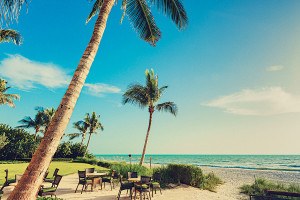
A New England Traveler’s Guide to Naples, Florida

24 Must-Visit Restaurants in Providence, Rhode Island
Stephen “The Rifleman” Flemmi’s Longtime Girlfriend Speaks
A conservative thought experiment on a liberal college campus, new restaurants to try in boston, april 2024, nine must-visit restaurants in burlington, vermont, you can own a very special cape cod barn for $1.75 million, in this section.

- San Antonio
- St. Augustine
- Washington DC
- HOME Main nav menu item
- MAPS & STOPS Main nav menu item
- Things to DO Main nav menu item
- SCHEDULE Main nav menu item
- FAQS Main nav menu item
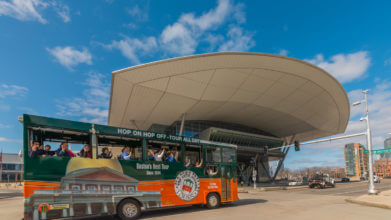
☆☆☆☆☆
★★★★★
1147 reviews
Old Town Trolley Tours of Boston 4.3
Freedom Trail
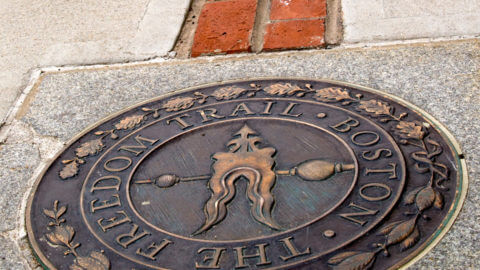
For the average Bostonian, life in the New England colonies during the 17th century was, as you might’ve guessed, not exactly one of ease and leisure. Before they were built by stone or brick masonry, homes were small, dank, drafty and made entirely of wood. This building practice was abolished toward the advent of the 1700s due to the susceptibility of fire. Most of the population subsisted as farmers, the drinking water was unsafe, medicine was still in the Dark Ages, and the average lifespan was just shy of 40 years. These were arduous and challenging times and living under the yoke of an oppressive foreign monarchy would eventually prove too much to bear and, thus, a revolution was born.
Comprised of 16 places of interest, each one a milestone in the evolution of Boston from English colony to independence, the Freedom Trail is an essential component of any trip to Boston . This historic attraction literally lays out Boston’s colonial history before you on the very streets where the city’s most transformative events unfolded several hundred years ago.
The thinking behind the design of the Freedom Trail is attributed to William Schofield, a former travel writer for the Boston Herald. He noticed that visitors eager to immerse themselves in the city’s historic past were having trouble finding the landmarks they were looking for. Schofield proposed a solution – Link the most important sites in a numbered sequence along a clearly marked, easy to follow trail that could be walked from end to end without the chance of getting rerouted or lost. There was also the idea that the Freedom Trail would’ve been a typical path to walk for the average colonist back in the day, further enhancing the sensation of traveling back in time.
Discover the magic of wintertime in Boston and embark on a historical “Transportainment ® ” adventure!
BEST WAY TO SEE THE FREEDOM TRAIL
Get MORE out of your summer in Boston aboard the iconic Old Town Trolley and see the best first!
As one of the most important cities instrumental in the forging of the republic Americans know today, the word ‘freedom’ takes on an even deeper meaning in the city of Boston. Rated by Forbes as one of the Top-Ten Best Tours in the city, Old Town Trolley Tours has applied that concept to how their tours are conducted by offering all-day hop-on, hop-off access. That means you can get off at any of the 18 stops anywhere in the city and explore the surrounding area for as long as you like. When you’re ready to re-board, simply return to the nearest pick-up/drop-off point and hop-on for more Boston adventuring! When it comes to the famous Freedom Trail, the trolley is never too far away from either of the 16 places of interest outlined on the red-brick path. As a matter of fact, the trolley stops at many of the landmarks along the Freedom Trail , making it easy and stress-free to take it all in along with the rest that this magnificent city has to offer!
Freedom Trail History
The Freedom Trail was the brainchild of local journalist William Schofield, who in 1951 suggested building a pedestrian trail to link together important local landmarks. These landmarks included Paul Revere’s house, the Old North Church , the Old State House , and the Old South Meeting House , all of which are historical gems. Schofield and then Boston Mayor John Hynes advocated for an organized route that linked them all together. Businessmen and women, elected officials, and non-profit organizations rallied together to designate a walking trail on Boston’s sidewalks in front of 16 historically significant locations.
Birth of the Freedom Trail
And so, the Freedom Trail was born. Just a few short years later, 40,000 people were walking the trail each year. And in 1958 the red line was added to clearly mark the trail. After being taken over by the National Park Service and being incorporated into Boston National Historical Park, the Freedom Trail was visited by more and more people. Today, more than three million people take the walk each year.
The Freedom Trail Includes 16 Official Historic Sites
Where Does the Freedom Trail Start
The start of the Freedom Trail is Boston Common . The length of the trail is 2.5 miles (4.0 km) and takes about 90 minutes to complete, but if you want to visit the sites along the way, it can be a whole day affair. The end of the trail is at the USS Constitution Museum . If you’re driving there, parking is available at the Boston Common Garage.
What To See on the Trail
An outdoor and indoor living history experience. You can begin your tour in the beginning, middle or the end, visiting the sites in any order you choose. The official start of the trail begins at Boston Common. The trail winds its way to the other sites including the Massachusetts State House, the Park Street Church (open summer time only), Granary Burying Ground, Kings Chapel, Kings Chapel Burying Ground, Benjamin Franklin Statue & Boston Latin School, Old Corner Book Store, Old South Meeting House, Old State House, Site of the Boston Massacre, Faneuil Hall, the Paul Revere House, the Old North Church, Copp’s Hill Burying Ground, the Bunker Hill Monument and the USS Constitution.
Each site offers a compelling look into the rich past of the American Revolution . Adults and children of all ages can learn the fascinating stories of the people, the places and the events that took place in colonial Boston as they walk the Freedom Trail.
Self-Guided Tours
A walk along the Freedom Trail can be experienced however you wish. If you’re one who likes to take your time, linger and learn; a self-guided tour may be just what you’re looking for. The Freedom Trail guides are another great way to see the sites and learn more about each one.
As one of the most popular historical tours in all of New England, the Freedom Trail’s Walk into History tours entertain and enlighten millions of guests each year. The 18th century costumed guides add a dramatic element to the tour; each one is a local Bostonian with a deep historical knowledge of the trail. You’ll hear intriguing tales of how the patriots and the colonists fought for freedom and how they succeeded in establishing what we know as the United States of America. Each tour is 90 minutes in length and is designed for individuals, groups, schools and more.
Boston Old Town Trolley Tours
Old Town Trolley is a convenient way to explore The Freedom Trail while maximizing your vacation time. With multiple stops along the 2.5 mile historic trail, you can hop on and off at the sites you want to visit and learn about the rest during our fully narrated 90 minute historic sightseeing tour. Find the lowest price and money-saying packages by purchasing tickets direct through our website.
Things To Do Nearby
Black Heritage Trail
The Black Heritage Trail features various homes, memorials, and sites that are significant in the history of Boston’s 19th century African American community. The first slaves arrived in 1638 and by 1705 there were over 400.
Approximate time to allow: 2 hours.
African Meeting House & Museum
Dedicated in 1806, the African Meeting House is the Oldest African American Church and was the First African Baptist Church. Over the years it also served as a school and a community meeting place. It was here that William Lloyd Garrison founded the New England Slavery Society, making it the center of the abolitionist movement. In 1972, the building was acquired by the Museum of Afro-American History and it was restored in 1987. Today, the museum commemorates African American history from slavery to the abolitionist movement, with a focus on educational equality.
OLD SOUTH MEETING HOUSE
Designed by architect Robert Twelves, the Old South Meeting House, one of the first stops along the Freedom Trail heading north, was built in 1792 in the red brick Georgian style with a steeple in the front and was originally a church. At the time it was built, it was the largest building in Boston and was the host to many gatherings that were too large for Faneuil Hall to accommodate. It holds a special place in the history of America as the place where Sam Adams and the Sons of Liberty rallied for support and organized the Boston Tea Party. Opened to the public in 1877 as a museum and meeting house, the Old South Meeting House, located between Washington and Devonshire streets along the Freedom Trail is one of the country’s first museums of American history .
USS CONSTITUTION
The order came down directly from the lips of this nation’s first commander-in-chief back in 1794. George Washington wanted to fortify the nascent nation under his watch with a Navy. Six frigates were built, which included the USS Constitution. She was built entirely in Boston and was the largest building project the city had ever seen. Today ‘Old Ironsides,’ the name she acquired during the War of 1812, stands as the oldest commissioned warship in the world still harbored here in the place of her birth. No longer asked to defend a nation against foreign aggression, the USS Constitution, one of the last stops along the Freedom Trail north of the Charles River , serves the public by promoting understanding of the Navy’s role in war and peace through active participation in public events and education through outreach programs, public access, and historic demonstrations.
View this post on Instagram Blue skies over Boston 💙 📸: @jgibsphoto . . . . . . . #oldtowntrolley #visitboston #boston #city #bostonian #newengland #thingstodoinboston #bostonlife #bostonbound #bostonusa #usa #america #history #familyfun #igboston #bostongram #bigcity #massachusetts #bostonmass #citylife #cityphotography #cityscapes #bostonlove #bostonma A post shared by Old Town Trolley Tours (@oldtowntrolley) on Jul 3, 2019 at 1:27pm PDT
Boston Summer Nights Tour and Charles River Cruise
Watch history shine under the moonlight! Discover Boston’s illustrious story aboard the Old Town Trolley and the Charles River Boat on this exciting evening tour. Take part in a unique adventure as the sun sets over the Charles River.
THE SITE OF THE BOSTON MASSACRE
On March 5, 1770, an angry mob gathered on Boston’s King Street demonstrating their rage over losing their jobs against the British Crown. Eventually, eight redcoats fired on the rabble resulting in several fatalities and injuries. This conflict became the rallying cry for patriots against their foreign oppressors by the likes of Paul Revere and Samuel Adams. The event caused the expulsion of British troops in Boston until their return four years later. The official marker on the Freedom Trail of this tide-turning event is located at the intersection of State and Congress Streets in Downtown Boston, outside the Old State House, a few yards away from where the Massacre took place. If you’re in town for a March wedding, you might be able to catch the reenactment that the Bostonian Society organizes for the public on the anniversary of the event.
THE BOSTON COMMON
As the oldest public park in the United States, the Boston Common is the starting point of the famed Freedom Trail. Much like New York’s Central Park, The Boston Common is located right smack in the city center and continues to be one of the most visited attractions, not just along the Freedom Trail, but in all of Boston. The story of this city and its people is firmly rooted in the history of this place beginning hundreds of years ago when the land was owned by its citizens and used as a grazing ground for cattle. After the Revolutionary War, the park became a popular locale for public speeches and rallies. Now, the Common offers a variety of activities and events, including theater and musical performances year round.
BOSTON GHOST TOUR
Old Town Trolley Tours invites you to explore Boston’s darker side aboard the city’s only “frightseeing” ghost tour , Ghosts & Gravestones. You’ll visit the streets where the Boston Strangler once prowled and hear local tales of murder and mayhem, ghosts and ghouls.
BOSTON TEA PARTY SHIPS & MUSEUM®
As the site of many game-changing historical events that helped galvanize a nation towards independence, the Boston Tea Party is widely-acknowledged as the tinder that helped spark a revolution. Located in the heart of the city’s Seaport District , this multi-sensory museum allows visitors to relive history with interactive exhibits, full-scale restored 18th-century ships, and a fully immersive tour led by a passionate team of historical actors that really puts the events commemorated by the Freedom Trail into perspective. As part of their commitment to bringing the events of this period into a sharper perspective, there is the opportunity to carouse with colonialists over a spot of tea and re-enact the Boston Tea Party itself!
View this post on Instagram 2 months from today we’ll be throwing tea in the harbor at the 245th Anniversary and Annual Reenactment of the Boston Tea Party! How will YOU be participating? #huzzah #tossthattea #december16 #bostonteaparty #bostonhistory #americanhistory A post shared by BostonTeaPartyShips (@bostonteapartyships) on Oct 16, 2018 at 2:16pm PDT
Approximate time to allow: 30 minutes.
You may also like...
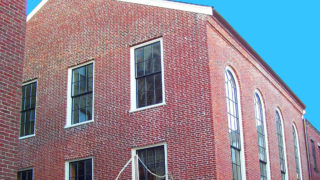
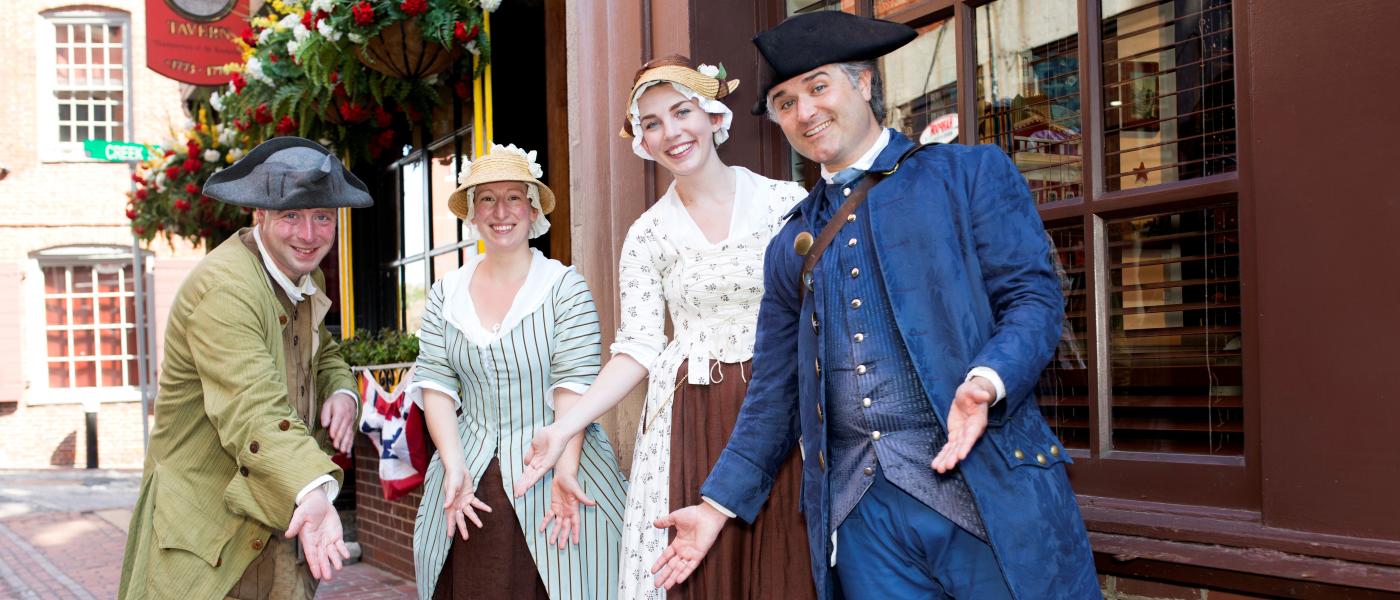
More In This Section Click to Open
Freedom trail google map.
Freedom Trail PDF Map
This website uses cookies to improve your browsing experience and analyze the use of the website. Learn More

Freedom Trail Tour

Tour Information
Freedom Trail
Freedom trail highlights.
- Boston Common
- Massachusetts State House
- Park Street Church
- Granary Burying Ground
- King's Chapel
- Old South Meeting House
- Old Corner Bookstore
- Old State House
- Boston Massacre Site
- Faneuil Hall
- and much more!
This page provides details of our free Boston Freedom Trail Walking Tour, including tips on directions, times, and sights covered.
Searching Availability...
Tour Description
Boston's historic center may be small, but it packs in so much history.
From an experiment in Puritan exclusiveness to an inclusive modern metropolis, every street, corner, and building whispers stories of the past.
The Boston Massacre and the original Tea Party took place here. Sam Adams, Ben Franklin, and George Washington all roamed its streets.
Before you take our tour, read our Freedom Trail Map and Guide for advice on parking, food, and maps.

Join Free Tours by Foot as we stroll the Freedom Trail's ancient streets, past historic cemeteries and colonial stone houses all the while hearing tales of rebellion, war, and the independence of a nation.
It's the epic story of Boston's rise and America's birth.
Before taking the tour, read up on some of the sites and characters covered on our Freedom Trail Sites List.
Sights we cover on the tour:
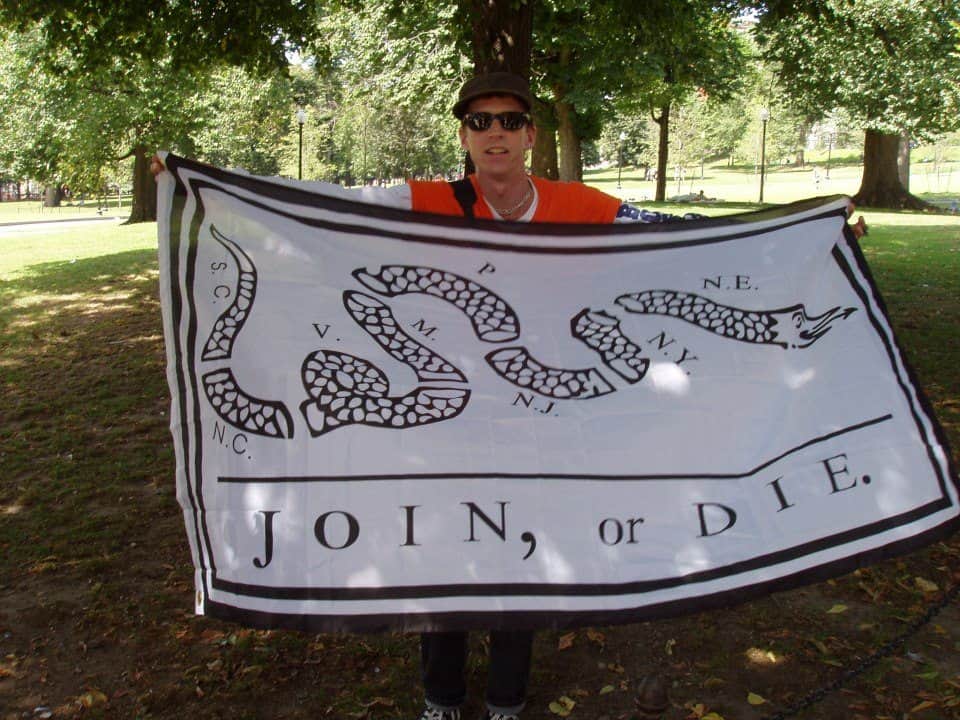
Reservations: REQUIRED. Click here to reserve . Groups of 6 or more must contact us before booking.
Where: Outside the Park St. T Station on the eastern edge of Boston Common ( map ). The tour ends at Faneuil Hall.
Duration: Approximately 2 hours. Tour distance is approximately 1 mile (1.6K)
When: View our full tour schedule .
This tour runs year-round
- Take this tour anytime with our GPS-enabled audio tour app .
Cost: This tour is free to take, and you get to decide what, if anything, the tour was worth when it's done. A name-your-own-price tour is a tour for anyone's budget.
Save even more money with a Boston tourist discount pass .
GPS Enabled Self Guided Tour of Boston

Can't make one of our guided tours? No problem, we have recorded some of our best tour guides giving their tours and put them up in an audio format.
Each tour offers an offline option to view the map and hear the audio of each walk so you don't need to have GPS maps running with the app.
Here is how it works:
- Purchase an Audio Tour
- Receive a confirmation email with all the details.
- Enjoy the tour(s).
Even if you don't download any tours, you will still have access to valuable information on sightseeing.
Listen to a sample of our Freedom Trail Tour.
And much, much more
North america, united kingdom & ireland, middle east & india, asia & oceania.

Freedom Trail
Phone: (617) 357-8300 Online at TheFreedomTrail.org
HOURS & ADMISSION
Freedom trail® tours.
Walk Into History Tours North End Tours Pirates & Patriots Tours
For a current tours schedule, please visit www.TheFreedomTrail.org
What is the Freedom Trail?
Boston’s official Freedom Trail® Tours take you to places where history was made! Walk Into History along the iconic Freedom Trail – the 2.5 mile red line leading to nationally significant historic sites , each one an authentic treasure. Preserved and dedicated by the citizens of Boston in 1951, the Freedom Trail is a unique collection of museums, churches, meeting houses, burying grounds, parks, a ship, and historic markers that tell the story of the American Revolution and beyond. Led by 18th-century costumed Freedom Trail Players®, tours feature tales of high treason, mob agitations, revolutionary actions, and partisan fights of the American Revolution. Discover the rich history of the American Revolution, as it began in Boston, where every step tells a story.
For more information, please visit TheFreedomTrail.org or call (617) 357-8300. Walk the Freedom Trail through history!
Freedom Trail Tours depart from two locations:
Boston Common Visitor Information Center
(139 Tremont Street)
ArtsBoston/Bostix Booth, Faneuil Hall (South side, near Samuel Adams statue)
Freedom Trail Tour Tickets: May be purchased at departure locations or online at TheFreedomTrail.org (discounted tickets available).
Hear History Audio Guide: The Freedom Trail Foundation also offers the Hear History: Audio Guide for purchase at the Boston Common Visitor Information Center or online at TheFreedomTrail.org .
- share Facebook
- share twitter
- share linkedin

Related Articles
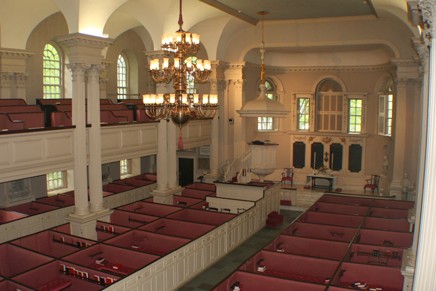
Attractions
Kings chapel & burying ground.
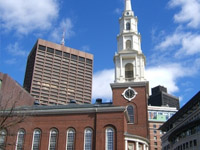
Park Street Church

Old State House
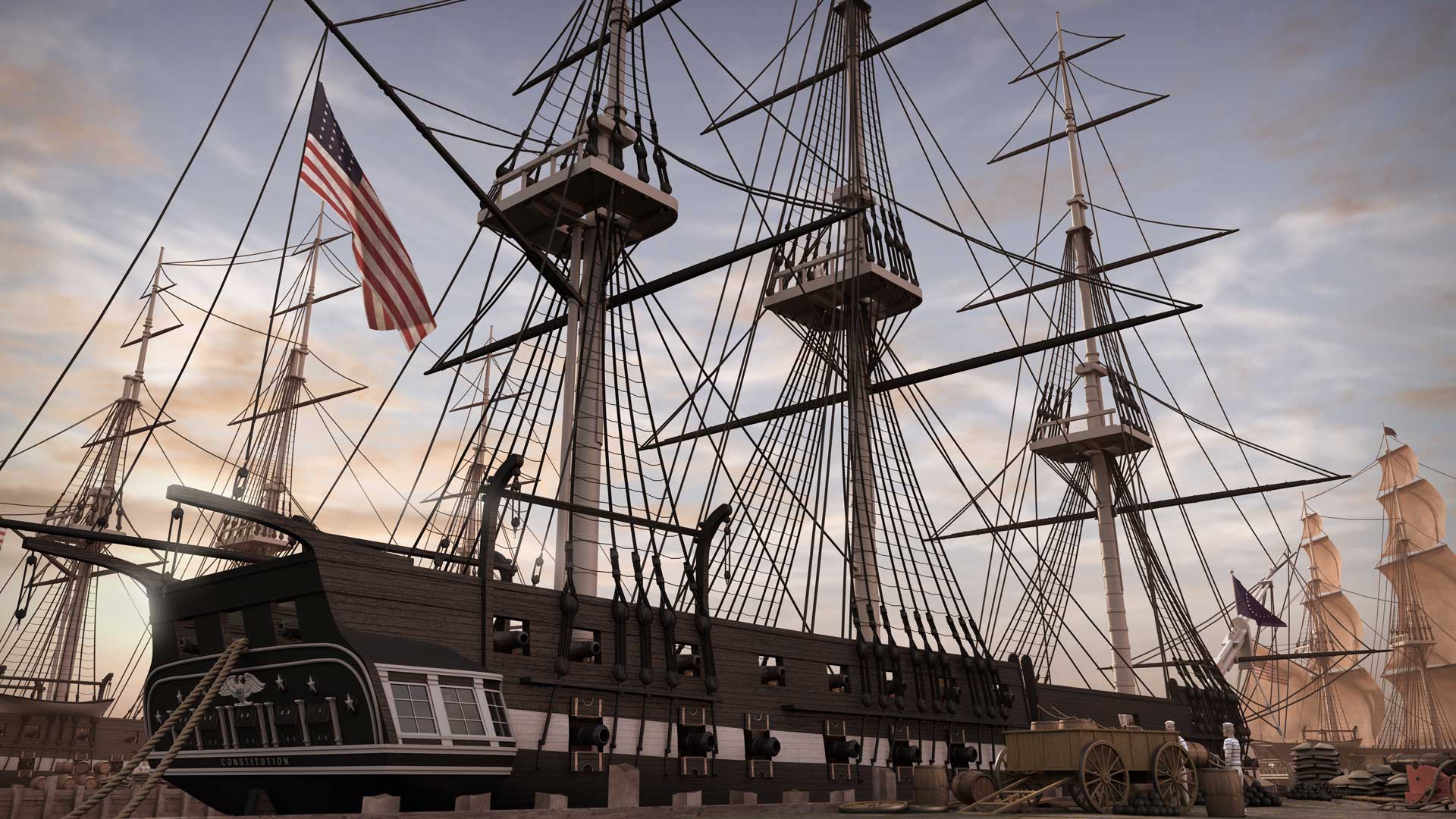
USS Constitution Museum
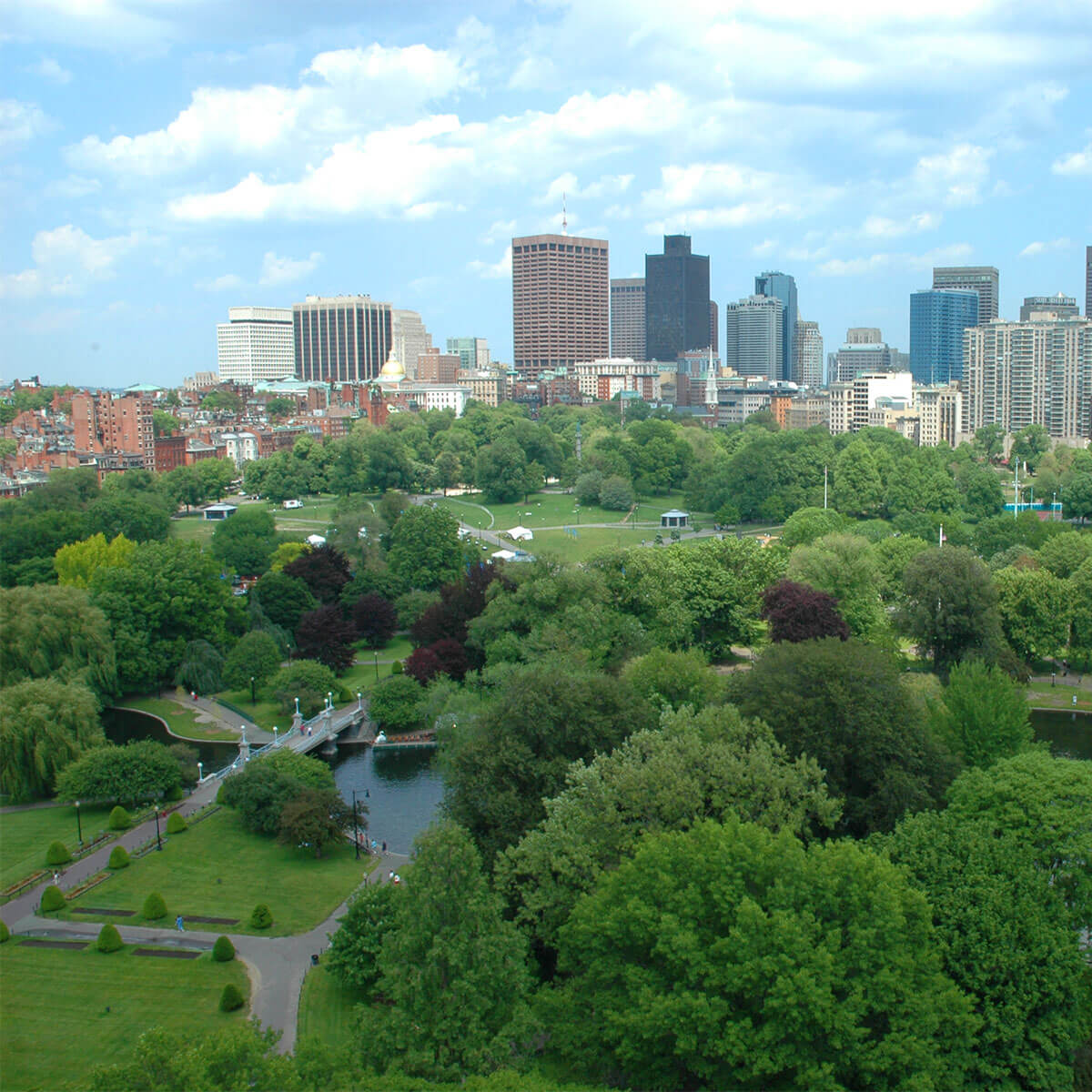
Boston Common
Signup for specials & discounts.
Sign up to receive special offers, discounts and news on upcoming events.
- Name sign up *
- Email Address *
SIGN UP FOR OFFERS & COOL BOSTON INFO

Our Adventure Journal
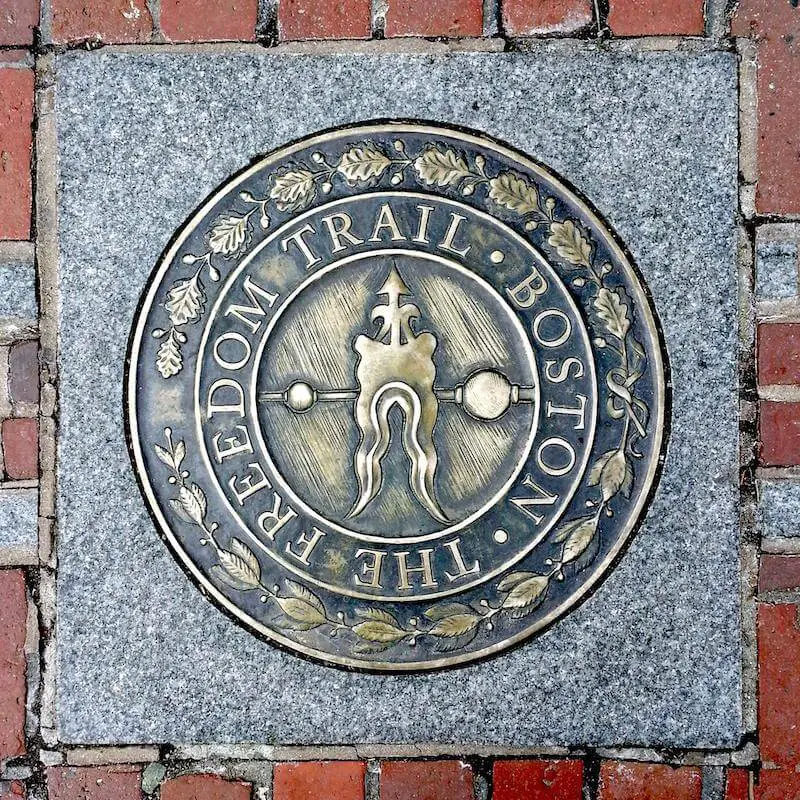
Full Guide to the Freedom Trail in Boston (History, Facts, and More!)
Last Updated on January 19, 2024 by Kelly
Boston is filled with historic landmarks, and the best way to see those landmarks is by walking the Freedom Trail . The Freedom Trail is a marked pedestrian trail that connects some of the city’s most important historical sites. A red brick line along the sidewalk will take you to the each historically-significant landmark. If you’re interested in learning about the Revolutionary War, you absolutely must walk the Freedom Trail.
We’ve walked the Freedom Trail many times, and we think it’s the best thing to do while in Boston ! My husband used to live in Boston, and we both spent several years living in Connecticut. We’d make frequent trips to Boston because it’s such a fun city. In this post, we’re sharing everything you need to know to walk the Freedom Trail in Boston .
About the Freedom Trail
Official Website: https://www.thefreedomtrail.org/
The city of Boston is a juxtaposition between the modern and the historic. For example, in the middle of a bustling city street, you’ll be able to see Paul Revere’s house. Or at the crossroads of a busy intersection, you’ll see the Old State House. It’s such a strange feeling to see buildings from the 1600 and 1700s adjacent to modern skyscrapers!
The Freedom Trail is 2.5 miles long (4 kilometers) one-way. To follow the trail, you just need to follow a red brick line that is embedded into the sidewalk. The trail contains 16 official historic sites. In front of each site, there is a special bronze marker . The Freedom Trail was established in 1951 .
Disclosure: This post may contain affiliate links. As an Amazon Associate, I may earn commissions from qualifying purchases.
You can walk the trail yourself, or you can book a guided walking tour of the Freedom Trail ! We’ve walked the Freedom Trail ourselves without a tour, but I definitely think it would be a good idea to book a tour. Unless you’re an expert on the Revolutionary War and colonial times, I think you’d get so much more from the experience with a tour!
How to Get to the Freedom Trail
The Freedom Trail officially starts at Boston Common park and it ends at the Bunker Hill Monument . However, you can start at either location. (If it’s more convenient to work backwards, you can absolutely do that).
If you’re flying into Massachusetts, you’ll want to book flights to Boston Logan International Airport (BOS).
If you’re taking the train to Boston, there are three Amtrak stations in the city: North Station, South Station, and Back Bay.
If you’re driving to Boston, you’ll want to research rental cars and parking garages in advance. The Boston Common Garage is the most convenient place to park. It’s actually located underground beneath the park!
Map of the Freedom Trail
We created this map of the Freedom Trail so you can easily see the 16 historic sites. We hope this map is helpful as you plan your walk along the Freedom Trail!
Tip: We recommend stopping by the Boston Common Visitor Center as you start the trail. You’ll be able to grab a visitor guide, brochures, and get answers to any questions you have prior to starting your walk.
Tours of the Freedom Trail
Before we share our tips for walking the Freedom Trail, we highly recommend that you consider booking a tour. Having a knowledgeable guide will provide you all the relevant history about each site you visit. Boston is steeped with history, so it’s super helpful to have an expert that knows the most interesting things to share!
Here are a few tours to consider:
- Guided Walking Tour : This tour takes approximately 70 minutes.
- Guided Walking Tour + Beacon Hill and Copley Square : This tour takes approximately 2 hours.
- Pizza + Walking Tour : Combine the Freedom Trail with some local eateries.
- Self-Guided Audio Tour App : When you purchase the app, you’ll be able to read about the sites as you walk at your own pace.
Tips for Walking the Freedom Trail
- Wear comfortable shoes while on the trail. You’ll be on your feet for a long time, so definitely wear shoes that have been worn in. (This is not the day for new shoes!)
- Bring a water bottle . You’ll want to stay hydrated as you walk.
- Plan your budget . Although walking the Freedom Trail is free, many of the points of interest along the way charge admission for entry.
- Make a plan for food . You don’t want to find yourself hangry on the trail. Later in this post we’ll share some great restaurants along the trail!
- Research some of the sites in advance. You’ll have a deeper appreciation once you know the history surrounding each site. We’ll share more below!
- If you have time in your itinerary, consider breaking up the trail over two days . The Freedom Trail contains many historical sites that double as museums. If you’d like to have lots of time to explore the museums and not feel rushed, consider walking the trail over two days. (Although this isn’t totally necessary. It just depends on how much time you want to spend at each site!)
The 16 Historic Sites on the Freedom Trail in Boston
The Freedom Trail will take you through Boston’s most famous historic sights. Here’s the full list:
1. Boston Common
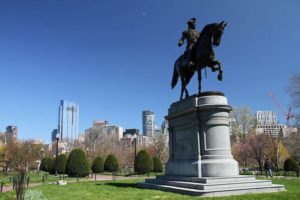
The oldest public park in the United States is Boston Common. It was established in 1634 , making it nearly 400 years old! Puritans purchased the land and it was used for their sheep to graze. It was called “The Common Land”, and as you can see, the name stuck!
In 1775, the land was used by the British army as a training ground during the Revolutionary War.
Before you even begin walking the Freedom Trail, there’s tons to see at this vibrant park. Be sure to check out the Robert Gould Shaw and 54th Regiment Memorial . The memorial honors the first all-Black volunteer regiment in the Civil War.
Adjacent to the Boston Common is The Public Garden. Between the two, there are over 70 acres of urban green space.
Some things to check out in this area include:
- Boston Frog Pond: During the summer, this is a free splash park. During the winter, there is ice skating.
- Boston Common Carousel: Take your kiddos for a ride on the carousel for a small fee.
- Make Way for Ducklings: A bronze statue of a mama duck with her ducklings.
- Soldiers and Sailors Monument: This memorial honors those who died in the Civil War. It was dedicated in 1877.
- Swan Boat Lagoon: This lagoon is located in The Public Garden. At the lagoon, you can ride in giant swan boats (open seasonally). The last day of the season for 2022 is September 5th.
- George Washington Statue: This large statue features President George Washington riding a horse.
- Central Burying Ground: Some of the oldest gravestones here are from 1756.
- Statue of Edgar Allen Poe: Technically right across the street from Boston Common, you can see this bronze statue of the famous poet and a raven.
You could easily spend several hours at the Boston Common and Public Garden. We wrote a full post about 25 things to see at Boston Common and the Public Garden with our tips. Make sure to save some energy for the rest of the Freedom Trail!
2. Massachusetts State House
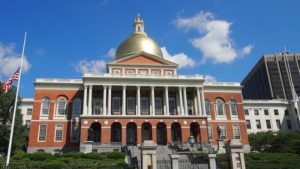
The Massachusetts State House is located across the street on the northern side of Boston Common. It opened in 1798 and houses the legislative and executive branches. John Hancock’s mansion used to be adjacent to the state house, but it was demolished to expand the state house many years ago. Although it was built in 1798, it’s known as the “new state house”. (You’ll find the older state house later on the Freedom Trail!)
You’ll be able to recognize the Massachusetts State House based on its giant golden dome. At the top of the dome is a gilt pinecone, which was used to honor the forests that allowed the earliest settlers to survive.
3. Park Street Church
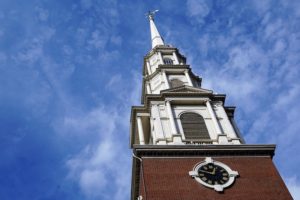
The Park Street Church was built in 1809. The steeple is 217 feet tall, and for many years it was the tallest building in Boston.
The church has played a crucial role in many social justice movements. William Lloyd Garrison delivered his “Address to the Colonization Society” at Park Street Church, which was the first major public statement in opposition to slavery.
The church is open to the public to tour only during the summer. Be sure to check in advance of your trip.
4. Granary Burying Ground
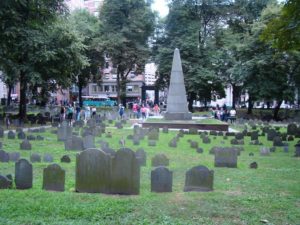
This burying ground was named for the granary which used to next door to it during colonial times. The Granary Burying Ground was established in 1660. No one has been buried there since 1880. It’s estimated that there are over 2,300 gravestones at this cemetery, with over 5,000 people believed to have been buried there.
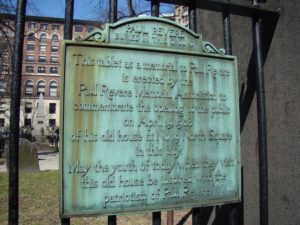
There are many notable Bostonians that have been buried at this cemetery. This includes:
- 3 signers of the Declaration of Independence (Samuel Adams, Robert Treat Paine, and John Hancock)
- Paul Revere (buried near the back)
- 5 victims of the Boston Massacre
- The large obelisk at the cemetery marks the tomb of Benjamin Franklin’s parents
Many of the slate gravestones contain depictions of the “Soul Effigy” (a skull with wings on both sides), the Grim Reaper, and Father Time.
5. King’s Chapel and King’s Chapel Burying Ground
Boston’s first Anglican church was built here in 1686, and the present-day building was constructed in 1754. King’s Chapel has the oldest American pulpit that is still in continuous use. The interior of the church contains Georgian architecture.
The church also contains a bell that was forged in 1772. When it cracked in 1814, it was recast by Paul Revere himself.
When I walked through this church, I was first struck by the boxes of pews. I learned that each wealthy family paid rent to the church to have their own private box pew. The pews were surrounded by walls to help protect from winter drafts. The pews you see today are the original pews. (Although they have been upholstered over the years.)
If you take the Bells & Bones tour at the church, you’ll get to see the crypt as well as the bell tower.
6. Boston Latin School Site & Benjamin Franklin Statue
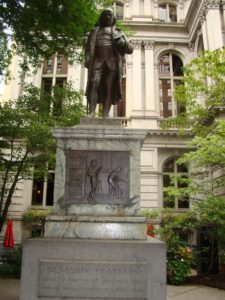
The Boston Latin School is the oldest public school in the United States. It was founded all the way back in 1635. One of its former students was Benjamin Franklin, hence the statue out front. (Although interestingly he was a drop-out!) The church was torn down in 1745 in order to expand King’s Chapel, but you can see the statue and mosaic representing its original location. (The school, however, continues at a different location!)
7. Old Corner Bookstore
The Old Corner Bookstore, built in 1718, is Boston’s oldest commercial building. It was originally built as an apothecary, and later a publishing house. Some of the best writers in the United States published here, including Harriet Beecher Stowe, Nathaniel Hawthorne, Henry Wadsworth Longfellow, and Ralph Waldo Emerson.
In 1960, the Old Corner Bookstore was going to be demolished in order to build a parking garage of all things. Thankfully, Bostonians were able to raise money to protect the property.
8. Old South Meeting House
This is where the Boston Tea Party began! The tea tax debates were held at the Old South Meeting House. Over 5,000 people crowded into the building to debate the taxes on imported tea. When no resolution was achieved, the colonists went to the harbor and threw all the tea into the water. This was one of the major events that ignited the Revolutionary War.
This building was also going to be demolished in 1872, but it was saved by 20 women and turned into a museum instead.
The Old South Meeting House was the largest building in colonial Boston, so it makes sense that the majority of public discourses, speeches, and debates were held here.
(Please note that you can purchase a combined admission ticket to both the Old State House and the Old South Meeting House.)
9. Old State House
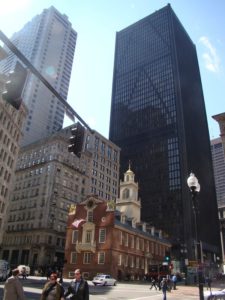
The oldest surviving public building in Boston is the Old State House. It was built in 1713. When I visited this portion of the Freedom Trail, I was truly amazed to see this historic brick building surrounded by skyscrapers.
Prior to the Revolutionary War, the royal governor (an office appointed by the King), would give speeches from the balcony.
10. Boston Massacre Site
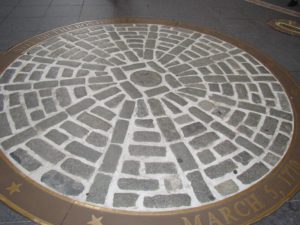
Directly in front of the Old State House is the site of the Boston Massacre. On March 5th, 1770, after escalating tensions, 5 Bostonians were killed by British Redcoats.
The site is located at the intersection of State Street and Congress Street. Interestingly, the commemorative plaque has been moved twice to allow for changing traffic patterns.
If you are in Boston on May 5th, there’s an annual re-enactment hosted by the Bostonian Society.
11. Faneuil Hall
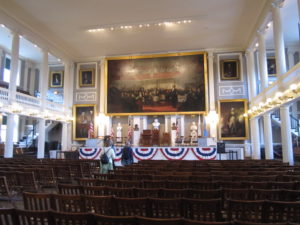
Faneuil Hall is where the the first Town Meeting in America was held. It’s been named “the home of free speech” and the “cradle of liberty.”
The building was a center for commercial activities in Boston. In 1741, the Sons of Liberty officially announced their dissent against the Royal Crown here.
Atop the hall is a weather vane depicting a golden grasshopper.
Tip: Feeling hungry? Right across from Faneuil Hall is Quincy Market. The market contains lots of different food vendors, so it’s the perfect spot for your party to take a break and grab a meal. The last time I was at Quincy Market, I especially enjoyed a cup of clam chowder and a lobster roll!
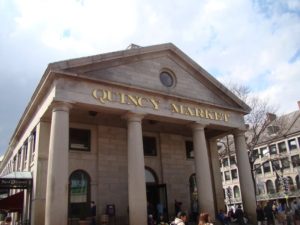
12. Paul Revere House
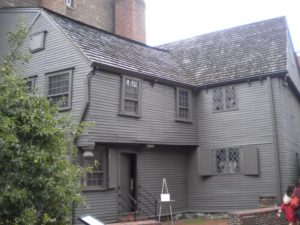
The oldest structure in all of downtown Boston is the Paul Revere House. It was built around 1680, and patriot Paul Revere purchased the home in 1770.
Over the years, this house has also been a candy shop, cigar factory, and Italian bank.
The home now contains and visitor center and lots of educational programming around his famous midnight ride. You can enter the home for a small fee. (At the time of this writing, an adult ticket costs $6.)
13. Old North Church
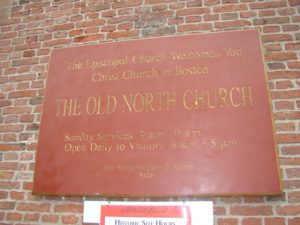
The Old North Church, built in 1723, is especially known for its role in the Revolutionary War. It was here that Paul Revere’s message “One if by land, two if by sea” was carried out via lanterns. After that evening, the Revolutionary War began.
14. Copp’s Hill Burying Ground
The Copp’s Hill Burying Ground was named after a shoemaker. This was Boston’s largest burying ground. Gravestones from this cemetery date back to 1659.
15. USS Constitution
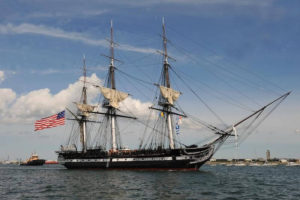
The USS Constitution is a warship that was built in 1797. It was nicknamed “Old Ironsides” during the War of 1812, and it continues to float today! The ship will occasionally sail through Boston Harbor for special occasions. At the site of the USS Constitution is also a museum.
16. Bunker Hill Monument
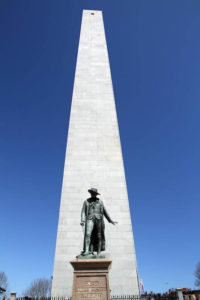
The last stop on the Freedom Trail is the Bunker Hill Monument. The Battle of Bunker Hill took place on June 17th, 1775, and was the first major battle of the Revolutionary War.
It was here that the statement, “Don’t fire until you see the whites of their eyes” was first proclaimed.
At this battle, there were over 3,000 Redcoats. Although the colonists technically lost this battle, it took the British three separate assaults to achieve victory. This battle really demonstrated that the colonists could put up a fight.
Across from the monument is the Bunker Hill Museum. At the museum, you can learn all about the Battle of Bunker Hill, the construction of the monument, and more generally about the Charlestown neighborhood.
If you made it this far, you’ve officially completed the Freedom Trail! Your feet are probably pretty tired, so it’s time to sit down for a good meal and rest!
Other Historic Sites in Boston
Although the Freedom Trail captures 16 sites, there’s plenty more places in Boston that are steeped with history!
Here’s a few other places you might want to visit:
- Black Heritage Trail: Learn about Black history in the Beacon neighborhood
- Boston Irish Famine Memorial: Two groups of statues honor the Great Famine
- African Meeting House: Frederick Douglas gave a famous anti-slavery speech here in 1860.
- Gibson House Museum: See what daily life was like in this mid 19th-century mansion.
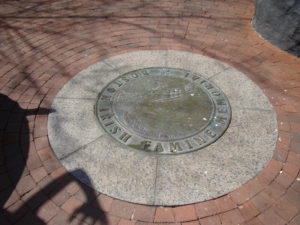
Where to Eat Along the Freedom Trail
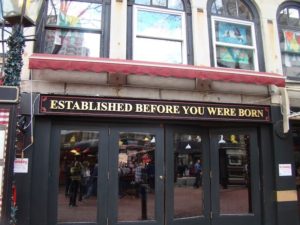
If you’re looking for a bite to eat as you wander the Freedom Trail, here’s a few places within walking distance to consider:
- Cheers Bar: The original Cheers bar is located across from the Public Garden on Beacon Street. This is the bar that inspired the show Cheers.
- Parker’s Restaurant: Located near Boston Common, you can go to the restaurant where the Boston Cream Pie was invented.
- Modern Pastry: Located near the Paul Revere house, Modern Pastry specializes in Italian and American pastries. You can build your own cannoli for the ultimate fresh cannoli!
- Union Oyster House: This is the country’s oldest restaurant. It was established in 1826. It’s about a 3-minute walk from Faneuil Hall. We recommend reserving a table.
- Quincy Market: Located across from Faneuil Hall, get Boston Baked Beans with brown bread, clam chowder, lobster rolls, and more. There are over 100 stores at Quincy Market, so you are sure to find something. (This also marks a fairly convenient half-way point along the trail, so it’s a great place to stop for a rest.)
- Mike’s Pastry: About a 4-minute walk from the Old North Church is Mike’s Pastry. The pastry shop is famous for their cannolis, so you definitely have to stop by and get a box!
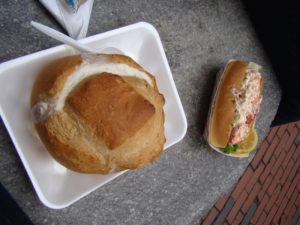
Frequently Asked Questions (FAQs) About the Freedom Trail
Where does the freedom trail start.
The Freedom Trail officially starts at Boston Common, which is the oldest public park in the country. The first stop is the Boston Common Visitor Information Center (139 Tremont St). From there, you’ll head north to see the Massachusetts State House on Beacon Street.
What is the Freedom Trail?
The Freedom Trail contains 16 historic sites in Boston that are connected by a red brick line in the sidewalk. It allows visitors to easily find some of the most important historical sites in the city. Many of the sites were notable for their role in the Revolutionary War.
How long does it take to walk the Freedom Trail?
If you simply walk along the trail to see each of the 16 sites from the outside, you can complete the trail in about 2 hours. However, we recommend dedicating a full day in your itinerary to the Freedom Trail. Many of the sites have museums, so if you’re interested in looking inside and learning more historical information, you could easily spend more time along the trail. When we last walked the Freedom Trail, it took us about 5 or so hours. We visited several of the museums, and we stopped for lunch along the way.
What Boston hotels are near the Freedom Trail?
If you’re looking for a hotel near the Freedom Trail, we recommend staying at the Omni Parker Hotel , which is close to Boston Common. If you stay at the Omni, you’ll be able to easily walk over to the start of the Freedom Trail first thing in the morning. If you want to book a hotel near the end of the Freedom Trail, we recommend the Residence Inn by Marriott Boston Harbor on Tudor Wharf . The hotel is just a 10-minute walk from the Bunker Hill Monument.
Does the Boston Latin School still exist?
The Boston Latin School continues to exist, but it’s in a different location. The first schoolhouse built in the mid 17th century was torn down in order to expand King’s Chapel. The Boston Latin School, however, continues to operate at a different location. It’s the oldest public school in the United States.
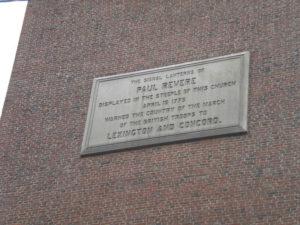
Best Hotels Near the Freedom Trail in Boston
As you plan your trip to Boston, you’ll want to make sure you have good accommodations. Here’s a few places to consider:
Omni Parker House
The Omni Parker House is a 4-star hotel located directly adjacent to Boston Common, which is where the Freedom Trail officially starts. If you stay at this hotel, you’ll be just steps away from the Freedom Trail. The rooms at the Omni Parker House feature historical decor alongside modern amenities. If you’re a foodie, you’ll be pleased to know that the Boston Cream Pie was invented at Parker’s Restaurant within the hotel. Be sure to stop by their restaurant for a slice!
The Bostonian Boston
The Bostonian Boston is located right next to Faneuil Hall Marketplace. You can also request a room that overlooks the historic marketplace. This hotel is located about halfway through the Freedom Trail, which means that you can easily walk to any of the historical sites.
Residence Inn by Marriott Boston Harbor on Tudor Wharf
The Residence Inn by Marriott Boston Harbor on Tudor Wharf is located right on Boston Harbor. Many of the rooms have water views. This hotel is located near the end of the Freedom Trail. In addition to being steps away from Boston Harbor, this hotel is also very close to the Bunker Hill Monument. This is a great hotel to choose if you want to be near Boston’s North End. Each suite features a full kitchen, and there’s a complimentary hot breakfast included in the nightly rate. This hotel also has an indoor swimming pool.
Summary: Our Adventure on the Freedom Trail
I’ve walked the Freedom Trail several times over the years. I’ve walked it with my parents, my husband, my aunts, and my friends. I’ve enjoyed walking the Freedom Trail each and every time, and I always learn something new! It’s easy to get overwhelmed by the sheer amount of history packed into the 2.5-mile trail. I recommend that you pace yourself, take frequent breaks, and enjoy everything the trail has to offer!
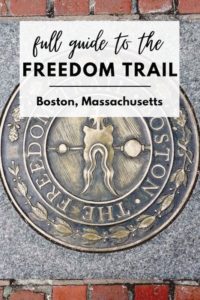
Disclaimer: We always strive for content accuracy. Since the time of publishing, travel-related information regarding pricing, schedules, and hours may have changed. Please look up such information directly from each vendor or institution for the most current information.
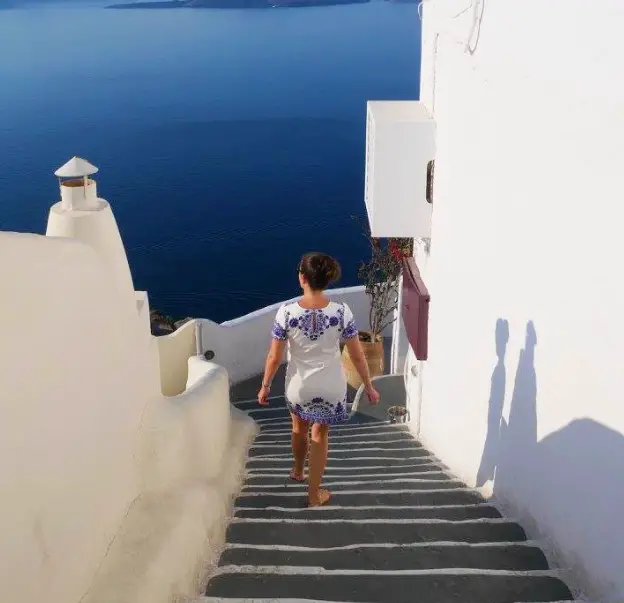
Hi, I’m Kelly!
After studying abroad in Spain, I became passionate about international travel. Since then, I’ve traveled to 6 continents and 36 states within the United States. When I’m not travel blogging, you can find me hiking, reading books in Spanish, or playing cribbage. I hope my blog inspires you to see the world!

- Skip to global NPS navigation
- Skip to this park navigation
- Skip to the main content
- Skip to this park information section
- Skip to the footer section

Exiting nps.gov
Alerts in effect, freedom trail audio tour.
Last updated: December 20, 2023
Park footer
Contact info, mailing address:.
Boston National Historical Park 21 Second Ave Charlestown, MA 02129
617 242-5601
Stay Connected

How a Boston Freedom Trail tour guide ended up on the ‘Jeopardy!’ Tournament of Champions
When you see Sean McShane on “Jeopardy!” March 6, he won’t be wearing his work uniform.
“I’m one of the guys you see in Boston Common in the tricorn hats and breeches,” the Southie resident said in a recent phone interview.
Talking to the 2019 Boston College grad (“I really broke the mold with that one: BC guy moves to Southie. Call me a trailblazer.”) feels like talking to a stand-up comic who happens to be good at trivia. Which is basically his job, he says, as a costumed tour guide on Boston’s Freedom Trail.
The job is “a weird combo of teaching a history class and stand-up comedy. You have to keep people entertained and roll with the punches, because you’ll get people who walk by and heckle: ‘There’s Redcoats afoot!’ I never know what to say to that.”
A three-day winner in December 2022 who won $80,401, McShane is now part of a field of 27 contestants in “Jeopardy!’s” Tournament of Champions, which runs through at least March 14. The first contestant to win three games scores $250,000 and a spot on the upcoming “Jeopardy! Masters” primetime event on ABC.
“Jeopardy!” nerds like me will be tuning in to see how this super-bracket plays out — especially as it’s the first tournament of champs to include a “Celebrity Jeopardy!” winner: actor/comedian/writer Ike Barinholtz plays March 4.
Aside from McShane, two others have New England ties, according to show info: Jake DeArruda, originally from Ludlow, Vt., competed Feb. 28. Brown University sophomore Justin Bolsen — the show’s first-ever “Jeopardy!” High School Reunion Tournament Champion — competes March 5.
I caught up with McShane — who will watch his episode at Southie’s Woody’s L Street Tavern — to talk about his Long Island fiasco, the WBZ video that shocked him, and embracing Southie.
Q. How did you first land on “Jeopardy!”?
A. I have a group of friends; we go to the L Street Tavern to watch “Jeopardy!,” our Monday night ritual. They’d been telling me for months, “You should take the test!” I was like, “I’m going to, I’m going to.” Which is Sean-speak for: I’m not going to.
Then one night [they were pushing] so I took the test. That was January 2022. In September, I got a call: “Hi, Sean, this is Corina from ‘Jeopardy!’” I sat up in my chair. She goes: “Are there any dates in the next two months that wouldn’t work for you?” I was like, “No, no, I’m wide open!” Then she goes: “OK, bye.”
I was like: What was that? Five days later, I get a text: “Can you come out October 24 to tape?” I was freaking out.
Q. How did you find out that you qualified for this tournament?
A. Out of the blue, the week of Thanksgiving, I get an email from a guy at WBZ, the CBS affiliate. He said they’re doing a piece on the Wildcard Tournament and wanted to speak to a past local contestant. I go in. It’s all the stock-standard questions: “Were you nervous?” ”What do you do with the money?” Then at the end, they tell me they actually have a message from “Jeopardy!” They play a video. It’s Ken Jennings. He says, “I’m sorry to tell you we will not be able to invite you back for the Champions Wildcard competition.” I’m like, “OK, this seems kind of mean-spirited.”
Then he goes, “Because you’re going straight to the Tournament of Champions!” My reaction was genuine shock. I never saw it coming.
Q. So you moved here in 2015 to attend Boston College. How long have you lived in Southie?
A. I grew up on Long Island. I moved to Southie in 2019. My first run [on “Jeopardy!”], they introduced me as “originally from West Islip, New York.” I changed it to South Boston partially because, since I was first on, friends who grew up in Southie told me I should say Southie. Which I know could be controversial. It’s like in “Jaws.” “You’re not born here, you’re not an islander.”
I mean it as an homage. It feels like home, a neighborhood in the truest sense. After my first episodes, I’d go to L Street Tavern, or the supermarket, and someone would grab me: “This is the ‘Jeopardy!’ guy!” My web of Southie people exploded because I was “Jeopardy!” Guy.
It’s funny: My first time on the show, my anecdote was: I rode my bicycle from the Canadian border down to Manhattan. Ken Jennings goes: “Oh, you didn’t decide to head out to the end of Long Island?” I didn’t know what to say; I was nervous. The first thing that popped into my head was: “I’m not missing much.” Ken laughed, the audience laughed — and when the laughter trailed off, you heard a few people go “Oooooh.”
Q. I remember that.
A. I thought: That’s going to come back to bite me. Then I completely forgot about it. A Long Island-themed Instagram account posted a clip and the hate comments — hundreds of people saying the worst about me.
A tabloid printed: Ken Jennings Left Stunned ! A Long Island newspaper had a story. I was waking up to Facebook messages from complete strangers: [in Long Island accent] “I thought what you said was hawrrible.” “I hope you lose!” Then a friend from Long Island texted me: The radio station is talking [expletive] about you on-air right now. So I called in.
I go, “This is Sean McShane, the ‘Jeopardy!’ guy that everyone hates.” They go: “We’re on with disgraced “Jeopardy!” champion Sean McShane! Sean, what do you have to say for yourself?” So I had to dial-up my accent: “It was a joke. I love Long Island!” [It eventually died down] but my friends and siblings thought it was the funniest thing: The first time Sean goes on TV he has to issue a public apology.
Some people might interpret my change of hometown as a [knock] to Long Island. I choose to frame it as a thank you to South Boston.
Q. You’ve had a job change since your last episode. You’re now a tour guide.
A. For the Freedom Trail Foundation . I’d always seen [costumed guides] around. I thought: Seems like fun. And it’s a lot of fun. You get people from all over the world. Once you can get over wearing breeches, a cravat, and a tricorn hat in public, you’re golden.
Q. Has it helped with history trivia?
A. Oh yeah. I was a history major, but I only knew the American Revolution from high school. I think anyone who’s good at “Jeopardy!” would probably be good at this. My knowledge of the American Revolution is much stronger.
Interview was edited and condensed.

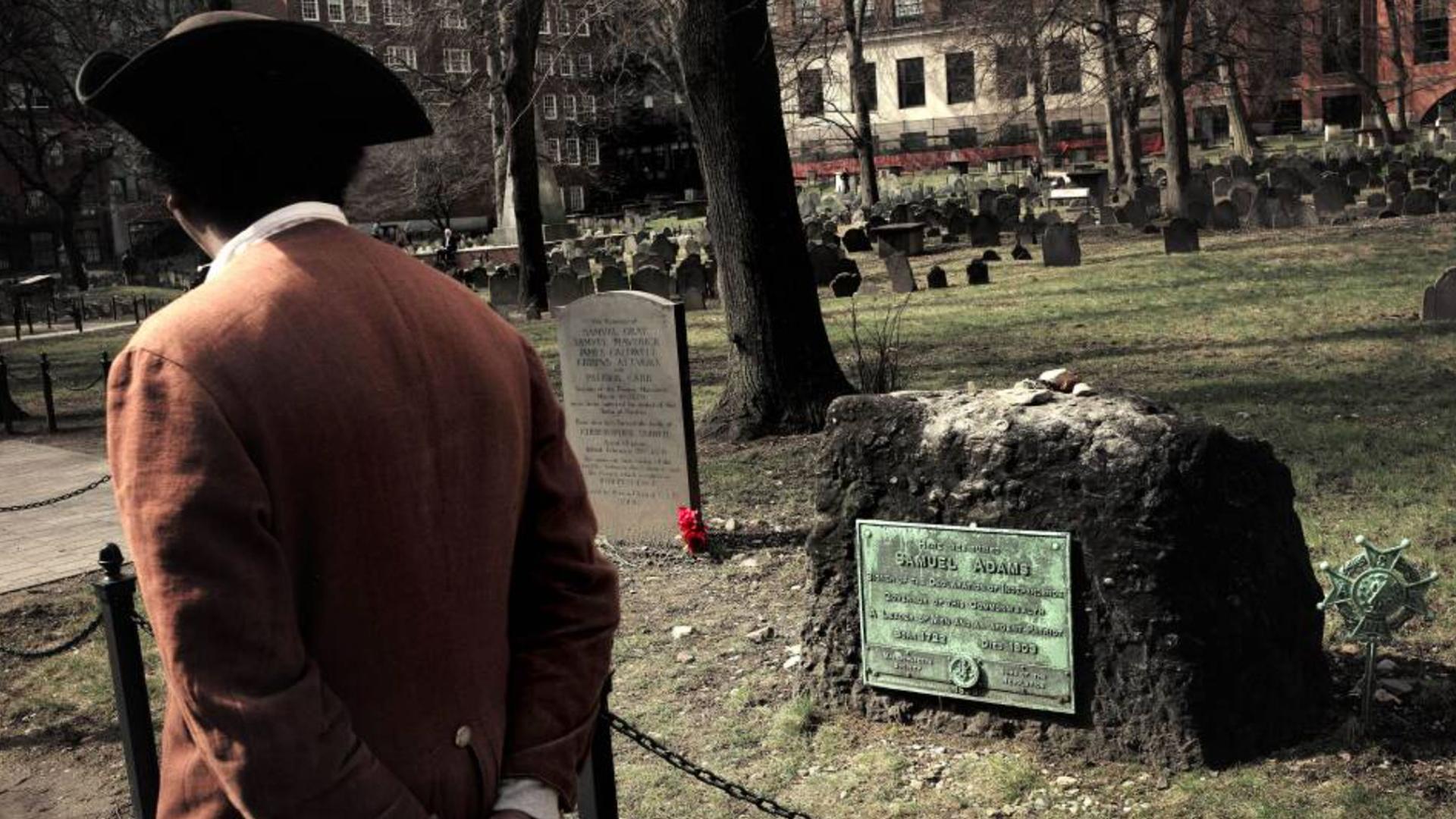
The history of enslavement at Boston’s Freedom Trail sites is beginning to be told
Boston is a cradle of American history, and 4 million people a year visit the historic churches, graveyards and parks that make up the Freedom Trail to learn more about the country’s origins. But rarely do they hear the underbelly of that story: that slavery touched nearly every aspect of the society and the economy of Massachusetts during that period of time. But that is now changing.
- By Paul Singer
Samuel Ike, of Cambridge, Massaschusetts, dressed in the role of Revolutionary War-era African American abolitionist Prince Hall, walks past the grave with red flowers of the victims of the 1770 shooting by British soldiers, known as the Boston Massacre, at the Granary Burying Ground in Boston. The grave of founding father Samuel Adams rests at right. March 3, 2020.
GBH Advisory: This project contains descriptions of violence and dehumanizing language to reflect the horrors that Black people and Native Americans were routinely subjected to during the era of American history when slavery was common. We recognize such language may distress some readers. Discretion is advised.
A narrow red brick path winds through the sidewalks of downtown Boston, connecting 17 historic sites tied to the city’s colonial history as the incubator of the American Revolution.
But the red line of the Freedom Trail also could symbolize the blood of enslaved people who helped make that revolution possible.
Boston is a cradle of American history, and 4 million people a year visit the historic churches, graveyards and parks that make up the Freedom Trail to learn more about the country’s origins.
But rarely do they hear the underbelly of that story: that slavery touched nearly every aspect of the society and the economy of Massachusetts during that period of time. But that is now changing.
In the 1700s, enslaved people likely accounted for about 10% of Boston’s population, according to the city’s tally . An unnamed French writer visiting Boston in 1687 wrote, “You may … own Negroes and Negresses; there is not a house in Boston, however small may be its means, that has not one or two.”
The malicious tentacles of slavery in the Bay State were widespread, although Massachusetts was not home to massive agricultural plantations like in the Southern colonies.
Boston thrived on shipping that involved transporting enslaved people or the products of their labor. The colony had a huge rum industry, made possible by the sugar harvested in the slavery-riddled Caribbean. And enslaved people in Central and South America mined the silver that Paul Revere used to manufacture his iconic kitchenware.
And those connections can be tied directly to sites along the 2.5-mile Freedom Trail: in the wood harvested by enslaved workers to build the USS Constitution; in the unmarked graves at Boston’s old cemeteries and in the history of Boston Latin School, where enslaver Nathaniel Williamsserved as one of the first schoolmasters.
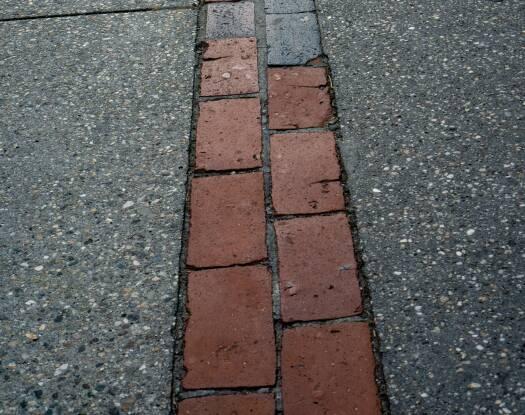
“We kind of give ourselves a lot of credit for being the first state to banish slavery,’’ he said. “But we were also the first state to make it legal.”
Massachusetts was the first colony to legalize slavery, with the adoption of the 1641 “ Body of Liberties ,” which set out the rules under which a person could be enslaved. Slavery was abolished in the 1780s through a series of court cases brought by enslaved people.
L’Merchie Frazier, former director of education and interpretation for Boston’s Museum of African American History, said the interpretation of the historic sites on the trail, installed in the 1950s, has completely ignored the role of Black people.
“Whose freedom are we trailing and are we tracing as we walk on those bricks?” L’Merchie Frazier, former director, Museum of African American History, Boston, Massachusetts
“Whose freedom are we trailing and are we tracing as we walk on those bricks?” she asked.
GBH News reporters worked with a group of Boston University journalism students to document the lesser-known history of slavery at each of the sites along the Freedom Trail. For several months, students dug into archives and worked with researchers to piece together information.
Some of the sites have done a lot of this work themselves and were able to share their findings; others, like the Old Corner Bookstore and the Boston Common, are essentially unmanaged and required students to dig through troves of documents and read historical texts looking for clues. While very little of what was found was previously unknown, there’s no easily accessible place to find all the information collected in one place.
View the interactive map: The Enslavement History of the Freedom Trail
Suzanne Segura Taylor, the executive director of the Freedom Trail Foundation, said her organization has long trained guides to mention slavery on the tour.
For example, the training materials direct guides to discuss the small grave marker beside the tomb of John Hancock, a two-time Massachusetts governor made famous for his signature on the Declaration of Independence. The small grave carries the name of “Frank,” described as a servant of Hancock’s and who was almost certainly enslaved, historians agree.
“Those are the things we say that must be talked about,” she said.
But, she said, more can be done to elevate the story of Boston’s slave history, and she hopes to share GBH’s findings with her tour guides.
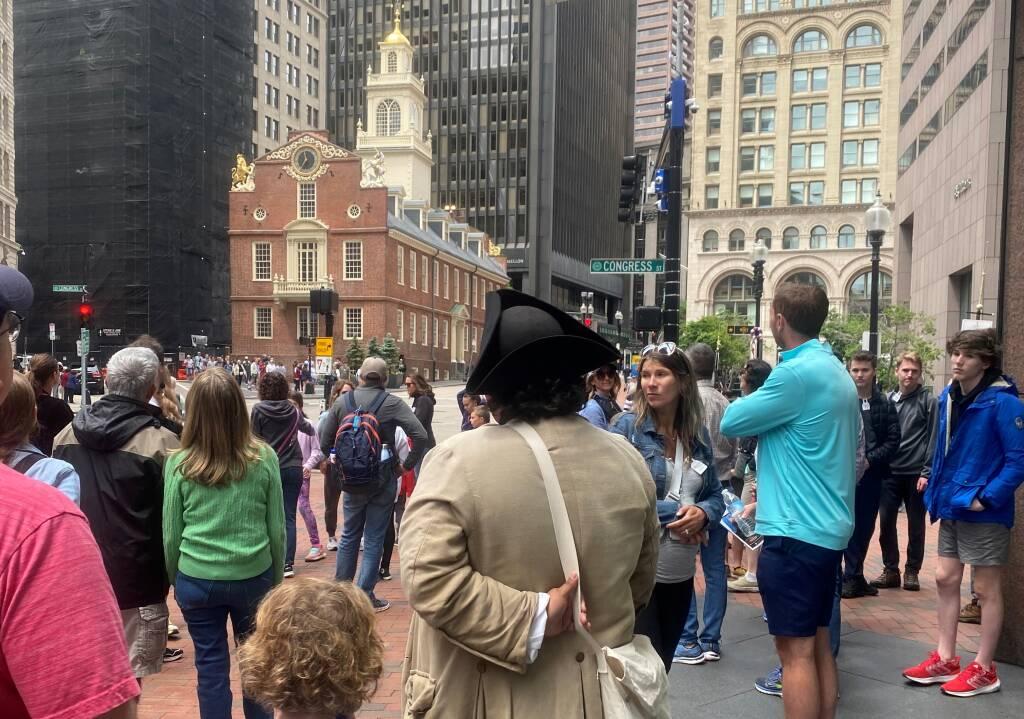
The Freedom Trail Foundation is just one of countless organizations leading tours of the historic sites. Last month, a GBH News reporter took a 2 1/2-hour walking tour with a private company that covered all 17 sites and never once mentioned slavery.
“There’s a lot of people out there conducting tours that we don’t know what their outlines are, what they’re required to discuss on their tours,” Taylor said.
Frazier said the story that tourists hear about colonial Boston depends on the guide.
“Previously on the Freedom Trail, the only mention of any Black person was Crispus Attucks — and not his history, just that he died on March 5, 1770,” she said.
Attucks, the first person killed in the Boston Massacre on that day, is buried with other victims under a commemorative stone in the Granary Burying Ground, beside revolutionary leader Samuel Adams. GBH followed several tours through the burial ground and the massacre site and heard no mention that Attucks — the child of an enslaved Black father and a Native American mother — had once been enslaved and advertised as a runaway.
Frazier also points out that the story of enslaved people in Boston is not just a story of victimhood. It is also the story of people working together to educate themselves, learn skills and try to build wealth — and fight for their freedom.
It was “a strategized, networked, organized movement to secure their voices, their land, their property,” she said. “If you leave out that narrative, that expanded narrative, of Black and Indigenous people here, you have really done a woeful job of delivering history. Especially in terms of considering the principles of democracy.”
While there is growing acknowledgement of the city’s ties to slavery on the Freedom Trail, the public-facing recognition of it is intermittent. For example, organizers at King’s Chapel, a stone chapel founded in 1686, launched an effort a few years ago to grapple with its history. Many of the founding members, and many of the donors to the construction of the church, were slaveholders, slave traders or otherwise made their money from the work of enslaved people.
Signs around the church now explain those connections, and the chapel recently approved a massive transformation to install a monument to the 219 enslaved people linked to the congregation’s history.
Watch how King’s Chapel is reckoning with its ties to slavery:
But just outside the church, the city-owned King’s Chapel Burying Ground provides no details about slavery on its signs, even though some of the most illustrious names on its tombstones commemorate people who owned slaves, including John Winthrop, the first governor of Massachusetts.
A “First Governor” plaque in the burial ground marks the family tomb and tells the story of Winthrop’s career, noting that he was “considered religious, prudent, conscientious and pious.” No mention is made of the fact that the governor sent soldiers to sack a Pequot settlement in 1627, taking hundreds of Native American prisoners, many of whom Winthrop sold, gave away as slaves or kept for himself.
Beth Anne Bower, credited as the historical research consultant on those signs, told GBH News that when the placards were made two decades ago, exploring connections to slavery “was not the conversation.” Instead, she said, she was encouraged to focus on the “diversity” of people buried there, highlighting women business owners and French migrants.
The current recognition that “we should start confronting this history” was not part of the mission for those signs, she said. “It should have been.”
Walking past the site of Boston Latin School — the oldest school in the nation — visitors would not learn that Nathaniel Williams, one of the school’s first schoolmasters, enslaved two people identified as Richard and Hagar. This fact is not mentioned on the school’s own website or on the mural painted on the sidewalk on School Street, which is named for Boston Latin. But these key details are available on other city websites .
Increasingly, the sites along the Freedom Trail — which are curated by different groups, including the National Park Service, the city of Boston, individual congregations and stand-alone nonprofits — have begun telling the stories of the foundation of enslavement that the city’s history stands upon.
The USS Constitution Museum in Charlestown, which receives hundreds of thousands of visitors a year, leads visitors through a hands-on description of how the ship was conceived and built.
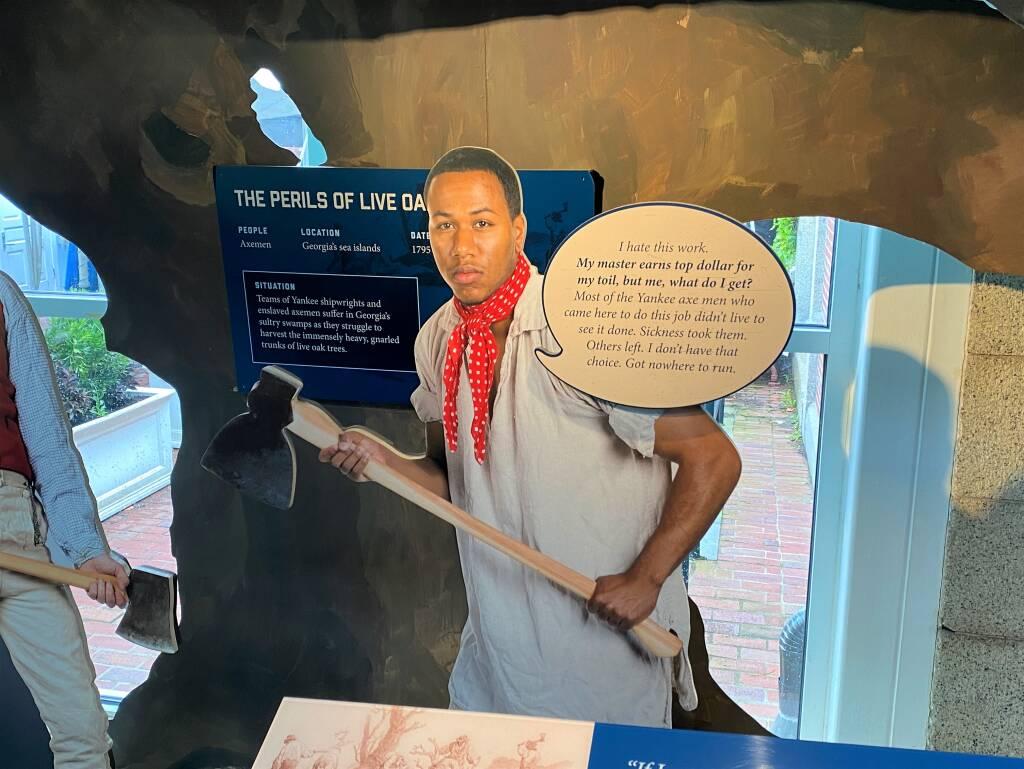
Dr. Carl Herzog, the historian at the museum, told Boston University students that the “live oak” — a particualry impregnable species of wood — that the US Navy sought to build the boat with in the 1790s came from Georgia’s St. Simons Island, where it was harvested by enslaved workers. In a blog post published on the museum website late last year, Herzog detailed the use of this wood: “Paying enslavers for the forced labor of enslaved people was an expediency that Navy officials and contractors saw as fundamental to the job. Thus, enslaved people were essential to the construction of naval warships built to secure the very American freedoms they were denied.”
The museum exhibit includes a modern life-sized photo of a Black man dressed as an “enslaved” worker carrying an axe. The attached sign says, “I hate this work. My master earns top dollar for my toil, but me, what do I get? … [White workers] left. I don’t have that choice. Got nowhere to run.”
Old North Church, where the lanterns were hung in the steeple “one if by land, two if by sea” to launch Paul Revere’s famous ride, has rewritten its own materials to expose the slave ties of the donors who funded that steeple.
The Old State House has an exhibit about the petitions enslaved people submitted to the Legislature in the 1700s asking for their liberation and reparations.
Stepping off the Freedom Trail, visitors can find even more of this history.
The National Park Service leads tours on a 10-stop Black Heritage Trail that features an alternate slate of sites curated by the Museum of African American History, including the African Meeting House — the nation’s oldest Black church building — and the John J. Smith House, home to a leading abolitionist who helped liberate Shardrach Minkins, an enslaved man from Virginia arrested in Boston in 1851 under the Fugitive Slave Act.
And the city of Boston has unveiled an exhibit inside Faneuil Hall to document some of the enslaved people who lived here and to highlight “Boston’s complicity” in the slave trade. The location was chosen specifically to elevate the fact that Peter Faneuil, who built the building donated to Boston in 1742, was one of the most active slave traders in the colony.
Some social justice leaders, like Imari Paris Jefferies, chief executive of Embrace Boston, who led the 2022 installation of the new civil rights memorial on the Boston Common, say this recognition is long overdue.
“To have more of these historic and legacy institutions on the Freedom Trail tell a holistic story about Boston’s — and by default America’s — involvement and engagement in this dark part of our history is an important part of reconciliation,” he said.
This story originally appeared on GBH’s Morning Edition.
Related: Benin is building a theme park to remember slavery — is history up for sale?
Sign up for The Top of the World, delivered to your inbox every weekday morning.

IMAGES
VIDEO
COMMENTS
There are countless ways to explore the Freedom Trail and its official historic sites. From year-round immersive programs and activities at the 16 historic sites to public and private walking tours led by 18 th-century costumed guides, National Park Service's Park Rangers, and more, to self-guided tours by foot with a map, guide book, or audio guide, there are exciting and comfortable methods ...
Tour of the Freedom Trail. Boston Common Visitor Center. (978) 741-1170. Tour of the Freedom Trail by The Histrionic Academy offers walking tours of Boston and the freedom trail using costumed historical interpreters as guides. These historians/tour guides are available for both public and private events.
A Walk Into History Tour, daily tours at 11 a.m., 12 p.m., 1 p.m., 2 p.m., 200 Atlantic Ave., Boston, 855-396-7433, trolleytours.com. The Freedom Trail Foundation's Walk Into History. On this 90 ...
Walk the Freedom Trail. Boston National Historical Park. Originally conceptualized in the 1950s, the Freedom Trail ® is an iconic symbol of Boston. Its red brick line snakes through some of the oldest parts of the City, navigating visitors to some of the most significant historic sites in the Downtown, North End, and Charlestown neighborhoods ...
Overview. Walk the Freedom Trail with a guide in historic costume on a tour from Boston Common to Faneuil Hall, a 1.2-mile route that covers important sites in the heart of Boston. This tour's shorter distance lets you follow in the footsteps of the founding fathers and American revolutionaries without making the more strenuous trek all the way ...
August 5, 2022. Boston's iconic 2 ½-mile Freedom Trail connecting 16 historical sites attracts more than 4 million visitors annually and was named one of the top American landmarks by Fodor's ...
As your guide leads your small group along the Freedom Trail, hear gripping stories from Revolutionary Boston and learn the significance of landmarks such as Granary Burying Ground, Old South Meeting House, the Boston Massacre Site, Old State House, Faneuil Hall, Paul Revere House, and more. Your walking tour concludes in Boston's North End on ...
Freedom Trail Map and Self Guided Tour. The Freedom Trail at the center of historic Boston is a red brick path through the city leading visitors to many of the city's historic sites. This self-guided tour and map will cover the entire 2.5 miles (4 km) and 16 Freedom Trail stops.
Our most recommended Freedom Trail Tours. 1. Boston: Guided Walking Tour of the Freedom Trail. See all 16 of Boston's iconic Freedom Trail sites in a single tour with an experienced guide. Learn about famous Americans like Paul Revere and John Hancock, along with lesser-known stories of women, African Americans, and immigrant patriots and ...
Where Does the Freedom Trail Start. The start of the Freedom Trail is Boston Common. The length of the trail is 2.5 miles (4.0 km) and takes about 90 minutes to complete, but if you want to visit the sites along the way, it can be a whole day affair. The end of the trail is at the USS Constitution Museum.
Park Street Church. Built in 1809, Park Street Church is the third stop on this self-guided tour of the Boston Freedom Trail. This Conservative Congregational church still averages around 2,000 in Sunday attendance and has around 1,000 members in total. The church was home to the first Sunday School in the United States, established in 1818.
The Walk Into History Tour is a 90-minute tour featuring 11 of the 16 Freedom Trail sites, some of which are in Boston National Historical Park. However, there are 16 official sites on the Boston Freedom Trail, which I will mention below. The Reverse Walk Into History Tour is the same tour, beginning and ending in the reverse locations.
Plan Your Visit. Experience the Freedom Trail Now. Access Information. Directions and Parking. Maps. Sample Itineraries & Resources. Foreign Language - Resources. Hotel Packages. Discounts & Savings.
This page provides details of our free Boston Freedom Trail Walking Tour, including tips on directions, times, and sights covered. Excellent Free Tours by Foot Walking Tours 4.7 ★ ★ ★ ★ ☆ Based on 200 reviews from See all reviews review us on Kim C ★★★★★ Andrew was a great guide and very knowledgeable. We really enjoyed the tour and learned so much!
Discover the rich history of the American Revolution, as it began in Boston, where every step tells a story. For more information, please visit TheFreedomTrail.org or call (617) 357-8300. Walk the Freedom Trail through history! Freedom Trail Tours depart from two locations: Boston Common Visitor Information Center. (139 Tremont Street)
The Freedom Trail in Boston is a 2.5 mile trail through Boston's historic center. There are 16 sites along the trail. ... Full Guide to the Freedom Trail in Boston (History, Facts, and More!) By Kelly June 16, 2022 January 19, 2024. Last Updated on January 19, 2024 by Kelly. ... Tours of the Freedom Trail.
Freedom Trail Audio Tour. The Freedom Trail ® is an iconic symbol of Boston. Its red brick line snakes through some of the oldest parts of the City. Use the map and the stop list below to explore and listen to stories about each site. The content can be used as a completely virtual tour, or as your own Park Ranger to take along as you walk the ...
16.8K Followers. How a Boston Freedom Trail tour guide ended up on the 'Jeopardy!'. Tournament of Champions. Story by Lauren Daley. • 1w. Visit The Boston Globe.
Boston is a cradle of American history, and 4 million people a year visit the historic churches, graveyards and parks that make up the Freedom Trail to learn more about the country's origins. But rarely do they hear the underbelly of that story: that slavery touched nearly every aspect of the society and the economy of Massachusetts during that period of time.